ATMA 2017 Question paper with answer key pdf conducted on February 12, 2017 for Set B is available for download. The exam was successfully organized by Association of Indian Management Institutes (AIMS). The question paper comprised a total of 180 questions.
ATMA 2017 Question Paper with Answer Key PDFs
| ATMA 2017 Question Paper with Answer Key | Check Solutions |
Question 1:
Carpenter : Furniture :: Sculptor : ?
View Solution
A carpenter works with furniture, just as a sculptor works with a statue. Both pairs show the relationship between a profession and the object created or worked on. Quick Tip: To identify the correct answer, think about the relationship between the professions and their associated products.
Monkey : Chatter :: Elephant : ?
View Solution
Monkeys chatter, and elephants trumpet. The pattern involves the sounds made by the animals. Quick Tip: Identify the sound associated with the animal in question to find the correct answer.
Ornithology : Birds :: Entomology : ?
View Solution
Ornithology is the study of birds, and entomology is the study of insects. Both pairs represent the field of study and the subject of that study. Quick Tip: Use the knowledge of scientific fields and their associated subjects to choose the correct answer.
Patricide : Father :: Sororicide : ?
View Solution
Patricide is the killing of one's father, and sororicide is the killing of one's sister. Both words refer to the act of killing a specific family member. Quick Tip: Think about the relationship between the act and the family member involved to solve the analogy.
Shooting : Bullet :: Archery : ?
View Solution
A bullet is used in shooting, just as an arrow is used in archery. Both pairs represent the object used in the respective activity. Quick Tip: Think about the tools or objects used in the activities mentioned to identify the relationship.
------- means the ridiculous and miserable failure.
View Solution
A "fiasco" refers to a complete and often embarrassing failure, especially one that happens in a ridiculous or mishandled way. Quick Tip: When referring to a failure, consider if the result was disastrous and embarrassing — if so, "fiasco" is the most appropriate choice.
Sharpness and bitterness of the speech or temper is known as
View Solution
Acrimony refers to sharpness or bitterness in speech, attitude, or temper. It is the quality of being caustic or sharply critical. Quick Tip: If the speech or temper is marked by sharpness or bitterness, "acrimony" is the correct word to describe it.
He looks at everything from a personal point of view.
View Solution
An "egocentric" person looks at everything from their own personal point of view, often without considering others' perspectives. It is a common characteristic of self-centered thinking. Quick Tip: For someone who constantly views things from a personal perspective, "egocentric" is the correct term to use.
Docile person is ?
View Solution
A "docile" person is easy to manage or handle, often quiet and compliant. They are not rebellious or hard to control. Quick Tip: When describing someone as docile, think of a person who is easy to teach or manage.
Which philosophy is expressed by a sentence, "God is nonexistent!"
View Solution
Atheism is the belief that there is no God, and the phrase "God is nonexistent!" clearly reflects this philosophy. Quick Tip: When someone denies the existence of God, they are typically expressing atheism.
Marie ------- by leaving Poland and travelling to France to enter the Sorbonne.
View Solution
Marie Curie defied societal expectations and norms by leaving Poland and going to France to pursue her education at the Sorbonne, which demonstrates her challenge against authority. Quick Tip: In this sentence, "challenged authority" fits the context of Marie Curie's bold decision to leave Poland and pursue education.
Even though she became fatally ill from working with radium, Marie Curie was never --------.
View Solution
Despite the health challenges from her prolonged exposure to radium, Marie Curie did not allow disappointment to deter her. Her determination to continue her work in science remained strong. Quick Tip: Look for the word that reflects Marie Curie's perseverance and refusal to be deterred by her illness.
Marie had a bright mind and a -------- personality.
View Solution
Marie Curie was known for her positive and lively disposition, which complements the fact that she was also brilliant. Her lighthearted personality helped her face challenges with optimism. Quick Tip: "Lighthearted" best reflects Marie Curie's cheerful personality, which balanced her serious scientific endeavors.
Her ------- began to fade when she returned to the Sorbonne to succeed her husband.
View Solution
Marie Curie’s emotional distress and sense of wretchedness started to subside when she returned to the Sorbonne to continue her work, replacing despair with purpose. Quick Tip: "Wretchedness" fits as it describes a state of intense sadness or hardship, which Marie Curie overcame as she resumed her work.
When she learned that she could not attend the university in Warsaw, she felt --------.
View Solution
Marie Curie was frustrated when she realized she could not attend the university in Warsaw due to restrictions on women, which led to her decision to leave Poland. Quick Tip: "Annoyed" fits the situation where Marie Curie’s frustration led her to challenge societal norms.
------- she remembered their joy together.
View Solution
Marie Curie’s memories of her time with her late husband Pierre Curie were filled with sadness and dejection, especially as she recalled their joy together. Quick Tip: "Dejectedly" fits best, as it reflects Marie Curie’s sorrow and emotional state when recalling the past.
The social worker ------- the two old sisters who were ill.
View Solution
The correct phrase is "called on" when referring to visiting someone at their house, making (D) the right choice. Quick Tip: When referring to visiting someone, use "called on" or "called at."
Abhishek was thrilled to be -------- such a beautiful and interesting lady.
View Solution
The correct phrase is "introduced to" when referring to being introduced to someone. Quick Tip: Use "introduced to" when referring to meeting or being introduced to a person.
"It is not very cold. I don't think we need these woollen sweaters."
"I don't think so, -------."
View Solution
The correct response is "I don't think so, either." This is a common structure used for agreeing with a negative statement. Quick Tip: "Either" is commonly used to agree with a negative statement, while "too" is used for positive statements.
If you don't understand the text, don't hesitate --------.
View Solution
The correct structure is "don't hesitate to [verb]," which is why "to ask a question" is the right choice. Quick Tip: After "hesitate," we always use the infinitive form of the verb (to + base form).
"Excuse me. Do you know where the railway station is?"
"It is ------- the bus terminal."
View Solution
The correct preposition is "opposite to" when referring to something being across from or facing something else. Quick Tip: Use "opposite to" when describing something located directly across from another location.
Enormous
View Solution
The word "enormous" means extremely large, so "tiny," the opposite, is the correct answer. Quick Tip: "Enormous" refers to something large, while "tiny" refers to something very small.
Exodus
View Solution
"Exodus" refers to a mass departure, and "arrival" is the opposite term indicating coming in. Quick Tip: "Exodus" refers to leaving or exiting, while "arrival" refers to coming in.
Quiescent
View Solution
"Quiescent" means in a state of rest or inactivity, so the opposite, "active," is correct. Quick Tip: "Quiescent" refers to being at rest, and "active" refers to something that is moving or doing something.
Commissioned
View Solution
"Commissioned" means to formally start a project or role, so "revoked" is the opposite, meaning it is taken back. Quick Tip: "Commissioned" means to begin or start, while "revoked" means to cancel or take back.
Relinquish
View Solution
"Relinquish" means to give up or release something, so the opposite action, "possess," means to own or keep something. Quick Tip: "Relinquish" refers to giving up something, while "possess" means to own or have something.
Proxy
View Solution
"Proxy" refers to someone authorized to act on behalf of another, so "authorized agent" is the most fitting option. Quick Tip: A proxy is a person who is authorized to act for someone else, typically as an agent.
Mundane
View Solution
"Mundane" means something ordinary or worldly, hence "worldly" is the correct synonym. Quick Tip: "Mundane" refers to something that is ordinary or lacking excitement, which is synonymous with "worldly."
Inured
View Solution
"Inured" means to become accustomed to something unpleasant or difficult, which is close to "hardened." Quick Tip: "Inured" typically refers to becoming accustomed to something through exposure, similar to being "hardened" against it.
Patronize
View Solution
"Patronize" means to support or sponsor, typically in the context of business or charity. Quick Tip: "Patronize" often refers to supporting or sponsoring something, especially a cause or service.
We must finish this job ------ next Monday.
View Solution
"By" is the correct preposition to use when referring to a deadline or when something must be completed before or at a specific time. Quick Tip: "By" is used to indicate a deadline or specific point in time when something must be completed.
I often take walks ------ the morning.
View Solution
The correct preposition for time-related phrases is "in," such as "in the morning." Quick Tip: "In" is used with periods of time like "in the morning," "in the evening," etc.
The college library is open ------- nine until four.
View Solution
When referring to a time range, "from" is used to indicate the starting time. Quick Tip: "From" is used to describe a starting point in a range, such as "from nine until four."
We cannot believe him because he never ------ the grandiose promises he had made.
View Solution
The correct phrase is "delivered on," meaning to fulfill or carry out the promises made. Quick Tip: "Delivered on" is used when referring to fulfilling or carrying out promises.
The reasoning the newspaper article is so ------- that we cannot see how anyone can be deceived by it.
View Solution
The correct word is "cogent," meaning convincing or logical, which fits the context of reasoning. Quick Tip: "Cogent" refers to reasoning or arguments that are clear, logical, and convincing.
Since Radha believed Krishna to be both candid and trustworthy she refused to consider the possibility that his statement is .
View Solution
The correct word is "insincere," meaning lacking sincerity, which would make sense in the context of doubting a trustworthy person. Quick Tip: "Insincere" refers to someone who is not genuine or truthful in their statements.
A smoke detector must always be placed
View Solution
The passage clearly mentions that a smoke detector should be placed outside each sleeping area, which includes all bedrooms in the home. Quick Tip: A smoke detector should be installed outside each sleeping area, which means all bedrooms.
What is the main focus of this passage?
View Solution
The main focus of the passage is the correct placement and installation of smoke detectors in the home to prevent fire-related hazards. Quick Tip: The main point of the passage is the proper installation and placement of smoke detectors to enhance safety.
The passage implies that dead-air space is most likely to be found
View Solution
The passage mentions that dead-air space is more likely to be found where the ceiling meets the wall, as this space can be missed by hot air. Quick Tip: Dead-air spaces are areas where hot air may not circulate properly, typically near where walls meet the ceiling.
A smoke detector should NOT be installed near a window because
View Solution
The passage notes that a draft near a window could pull smoke away from the detector, causing it to fail in detecting a fire. Quick Tip: A draft can interfere with a smoke detector's effectiveness by pulling smoke away from the detection area.
Which organizational scheme does this list of instructions follow?
View Solution
The passage presents instructions in a logical, step-by-step order based on the topics, such as placement and installation of smoke detectors. Quick Tip: Chronological order is used when presenting instructions or steps that need to be followed in sequence.
The passage states that, compared with people who do not have smoke detectors, persons who live in homes with smoke detectors have a
View Solution
The passage compares survival rates and states that having a smoke detector increases the chance of surviving a fire by 50%. Quick Tip: Smoke detectors can significantly improve survival chances in the event of a fire.
The passage indicates that one responsibility of a fire fighter is to
View Solution
The passage highlights that fire fighters speak to school children to educate them about fire prevention. Quick Tip: A key responsibility of fire fighters is educating the community, especially children, about fire safety and prevention.
According to the passage, how was Darwin’s book, On the Origin of the Species, received?
View Solution
The passage mentions that many religious opponents condemned Darwin's work. Quick Tip: Despite its scientific importance, Darwin’s work faced opposition, particularly from religious groups.
Which of the following statements supports Darwin’s belief about the origin of all species?
View Solution
The passage supports Darwin’s theory of evolution, stating that life forms evolved from lower species over time. Quick Tip: Darwin’s theory of evolution suggests that all life forms have evolved over time from simpler organisms.
According to the passage, Charles Darwin was which of the following?
View Solution
The passage describes Darwin as a biologist, emphasizing his role in developing the theory of evolution. Quick Tip: Darwin was a biologist known for his contributions to the theory of evolution.
Darwin’s explanation that the young of any species compete for food and survival, and those that survive are strong and pass their traits on to their young was called which of the following?
View Solution
This is a direct reference to Darwin’s theory of natural selection, where only the fittest survive and pass on their traits. Quick Tip: The theory of natural selection and survival of the fittest explains how species evolve through competition and adaptation.
GROVEL
View Solution
The correct meaning of "grovel" is "to crawl," especially when used metaphorically to describe someone acting in a submissive or servile manner. Quick Tip: "Grovel" generally means to lie or crawl on the ground in humility, often used figuratively to describe lowly behavior.
CONNOISSEUR
View Solution
A "connoisseur" is someone who has expert knowledge or training, particularly in the fine arts or culinary fields. Quick Tip: A connoisseur is an expert who is skilled in the appreciation of fine details, especially in art or food.
BANAL
View Solution
"Banal" refers to something that is dull, overused, or ordinary—essentially something common and lacking in originality. Quick Tip: "Banal" is often used to describe something unoriginal or excessively common.
CLANDESTINE
View Solution
"Clandestine" refers to something that is secret or hidden, usually due to illicit or unauthorized nature. Quick Tip: "Clandestine" is often used to describe secret activities or operations, especially those done in secrecy for security or illicit reasons.
SUBVERT
View Solution
"Subvert" means to undermine or overthrow something, such as a system, government, or authority. Quick Tip: "Subvert" typically refers to an attempt to weaken or overthrow an established system or authority.
(A)Modern film techniques
(B)are far superior
(C)than that
(D)employed in the past
View Solution
The error is in "than that." The correct form is "to those," so the sentence should read:
"Modern film techniques are far superior to those employed in the past." Quick Tip: Use "superior to" instead of "superior than" for comparisons.
(A)I believe
(B)that respect
(C)is more preferable than
(D)money.
View Solution
The error is in "more preferable than." The correct form is "more preferable to," so the sentence should read:
"I believe that respect more preferable to money." Quick Tip: Use "preferable to" instead of "preferable than" for comparisons.
(A)I enjoyed
(B)during my
(C)stay in
(D)Holland.
View Solution
The error is in "I enjoyed." The correct verb phrase should be "I had enjoyed during my stay in Holland." Quick Tip: "I enjoyed" should not be used with the preposition "during." Instead, use "I enjoyed my stay" or other correct phrasing.
Deep ideological ------- and internal power struggles -------- the government.
View Solution
The correct words are: "Deep ideological \underline{\hspace{2cm and internal power struggles \underline{\hspace{2cm the government."
The correct phrase would be: "Deep ideological divisions and internal power struggles paralyzed the government." Quick Tip: "Divisions" and "paralyzed" fit well in the context of a situation that disrupts the government.
A glue produced by bees to -------- their hives appears to contain antibiotic substances.
View Solution
The correct word is "build," as bees produce glue to build their hives. Quick Tip: "Build" is the most suitable word as it refers to the process of constructing something, in this case, the hive.
Unlike his calmer, more easygoing colleagues, the senator was -------, ready to quarrel at the slightest provocation.
View Solution
The correct word is "irascible," which means easily angered or quick to quarrel. Quick Tip: "Irascible" refers to a tendency to be easily angered or irritated.
Next day the newspaper was filled with the ------- details of the murder.
View Solution
The correct word is "macabre," meaning something disturbing or related to death. Quick Tip: "Macabre" is often used to describe something that is grim, disturbing, or related to death.
Jill was ------- by her employees because she often --------- them for not working hard enough.
View Solution
The correct words are: "Jill was \underline{\hspace{2cm by her employees because she often \underline{\hspace{2cm them for not working hard enough."
The correct sentence would be: "Jill was loathed by her employees because she often berated them for not working hard enough." Quick Tip: "Loathed" means disliked intensely, and "berated" means scolded or criticized angrily.
Find the value of \( (1-\frac{1}{3})(1-\frac{1}{4})(1-\frac{1}{5})...(1-\frac{1}{100}) \).
View Solution
The expression is the product of fractions: \[ (1-\frac{1}{3})(1-\frac{1}{4})(1-\frac{1}{5})...(1-\frac{1}{100}) \]
Let’s simplify each of these terms:
\[ 1 - \frac{1}{3} = \frac{2}{3}, \quad 1 - \frac{1}{4} = \frac{3}{4}, \quad 1 - \frac{1}{5} = \frac{4}{5}, \quad \dots \]
So the product becomes:
\[ \frac{2}{3} \times \frac{3}{4} \times \frac{4}{5} \times \dots \times \frac{99}{100} \]
Notice that many terms cancel out, leaving us with:
\[ \frac{2}{100} \]
Thus, the simplified product is \( \frac{1}{50} \). Quick Tip: Simplify each term individually, then multiply them together step by step. Look for cancellation patterns to simplify the product.
A man spends 2/5 of his salary on house rent, 3/10 of his salary on food and 1/8 of his salary on conveyance. If he has Rs.1400 left with him, find his expenditure on food.
View Solution
Let his total salary be \( x \). The total expenditure is \( \frac{2}{5}x + \frac{3}{10}x + \frac{1}{8}x \), and the remaining amount is \( x - \left(\frac{2}{5}x + \frac{3}{10}x + \frac{1}{8}x\right) = 1400 \).
\[ Expenditure on food = \frac{3}{10}x \]
After solving the equation for \( x \), we find \( x = 8000 \). Hence, expenditure on food is \( \frac{3}{10} \times 8000 = 2400 \). Quick Tip: Set up an equation for the total salary, then find the expenditure on food using the corresponding fraction.
A crate of oranges contains one bruised mango for every forty oranges in the crate. If three out of every four bruised oranges are considerably unsalable and there are 12 unsalable oranges in the crate, then how many oranges is there in the crate?
View Solution
Let the total number of oranges be \( x \). We know that the ratio of bruised mangoes to total oranges is \( \frac{1}{40} \). The unsalable oranges are \( \frac{3}{4} \) of the bruised mangoes, and we know that there are 12 unsalable oranges.
\[ Number of bruised mangoes = \frac{4}{3} \times 12 = 16 \]
Now, since bruised mangoes make up \( \frac{1}{40} \) of total oranges:
\[ \frac{1}{40} \times x = 16 \quad \Rightarrow \quad x = 640 \] Quick Tip: Use the ratio and unsalable oranges to calculate the total number of oranges in the crate.
The average age of a class of 39 students is 15 years. If the age of the teacher be included, then the average increases by 3 months. Find the age of the teacher.
View Solution
Let the total age of the students be \( 39 \times 15 = 585 \). When the teacher is included, the average increases by 3 months, so the new average age is 15 years 3 months. Let the teacher's age be \( x \).
Total Age of 40 persons: \[ \frac{61 }{4} 40= 610 \]
Age of The Teacher:
\[ (610 -585) years = 25 years \] Quick Tip: Set up the equation for the average including the teacher, then solve for the teacher’s age.
Distance between two stations A and B is 778 km. A train covers the journey from A to B at 84 km per hour and returns back to A with a uniform speed of 56 km per hour. Find the average speed of the train during the whole journey.
View Solution
The average speed is given by the formula:
\[ \frac{2 \times speed1 \times speed2}{speed1 + speed2} \]
Substitute the given speeds:
\[ \frac{2 \times 84 \times 56}{84 + 56} = \frac{2 \times 4704}{140} = \frac{9408}{140} = 67.2 \] Quick Tip: Use the harmonic mean formula for calculating average speed with different speeds.
Rajapur has a population of 88000, which is decreasing at the rate of 1200 per year. Rampur has a population of 42000, which is increasing at the rate of 800 per year. In how many years will the population of the two villages be equal?
View Solution
Let the number of years be \( x \). The population of Rajapur after \( x \) years is: \[ 88000 - 1200x \]
The population of Rampur after \( x \) years is: \[ 42000 + 800x \]
Setting them equal to each other: \[ 88000 - 1200x = 42000 + 800x \]
Solving for \( x \):
\[ 88000 - 42000 = 1200x + 800x \]
\[ 46000 = 2000x \]
\[ x = \frac{46000}{2000} = 23 \]
Thus, the population of the two villages will be equal in 23 years. Quick Tip: Set up an equation based on the change in population over time and solve for \( x \) systematically.
Two pens and three pencils cost Rs 86. Four pens and a pencil cost Rs. 112. Find the cost of a pen.
View Solution
Let the cost of a pen be \( x \) and the cost of a pencil be \( y \). From the two given equations:
\[ 2x + 3y = 86 \quad (1) \] \[ 4x + y = 112 \quad (2) \]
Solving the system of equations:
Multiply equation (2) by 3:
\[ 12x + 3y = 336 \]
Subtract equation (1) from this:
\[ (12x + 3y) - (2x + 3y) = 336 - 86 \] \[ 10x = 250 \quad \Rightarrow \quad x = 25 \] Quick Tip: Set up and solve a system of equations to find the cost of each item.
What is the square root of 0.0009?
View Solution
The square root of 0.0009 is \( 0.03 \). Quick Tip: Convert the number into scientific notation and then apply the square root rule.
Nine persons went to a hotel for taking their meals. 8 of them spent Rs.12 each on their meals and the ninth spent Rs.8 more than the average expenditure of all the nine. What was the total money spent by them?
View Solution
Let the total expenditure of the nine persons be \( T \).
The average expenditure per person is \( \frac{T}{9} \).
The ninth person spent \( \frac{T}{9} + 8 \).
Thus, the total expenditure is: \[ T = 8 \times 12 + \left( \frac{T}{9} + 8 \right) \] \[ T = 96 + \frac{T}{9} + 8 \] \[ T = 104 + \frac{T}{9} \]
Multiply the entire equation by 9: \[ 9T = 936 + T \] \[ 9T - T = 936 \] \[ 8T = 936 \] \[ T = 117 \] Quick Tip: Use algebra to solve problems involving averages. Express the total expenditure in terms of a variable and solve for it.
Evaluate: \( (303 \times 303 + 208 \times 208) \)
View Solution
We need to calculate: \[ (303 \times 303) + (208 \times 208) \] \[ 303 \times 303 = 91809 \quad and \quad 208 \times 208 = 43264 \]
Thus, the total is: \[ 91809 + 43264 = 135073 \] Quick Tip: Square the numbers separately and then add them to get the final answer.
Which of the following numbers is divisible by 3?
View Solution
To check divisibility by 3, sum the digits of the number and check if the sum is divisible by 3.
For 541326: \[ 5 + 4 + 1 + 3 + 2 + 6 = 21 \]
Since 21 is divisible by 3, 541326 is divisible by 3. Quick Tip: For divisibility by 3, add the digits of the number. If the sum is divisible by 3, then the number is divisible by 3.
Two numbers are in the ratio of 15:11. If their H.C.F. is 12, find the numbers.
View Solution
Let the numbers be \( 15x \) and \( 11x \), where \( x \) is a constant.
The HCF of 15 and 11 is 1, so the HCF of \( 15x \) and \( 11x \) is \( 12 \).
Thus: \[ x = \frac{12}{1} = 12 \]
Therefore, the numbers are: \[ 15x = 180 \quad and \quad 11x = 132 \] Quick Tip: Use the ratio to find the numbers by multiplying with the HCF.
If the sum of two numbers is 42 and their product is 437, then find the absolute difference between the numbers.
View Solution
Let the two numbers be \( x \) and \( y \).
We know: \[ x + y = 42 \quad and \quad x \times y = 437 \]
Solving the quadratic equation \( x^2 - (x + y)x + y = 0 \) gives the absolute difference \( |x - y| \).
The solution is 4. Quick Tip: For sum and product problems, solve the quadratic equation formed to find the numbers, then calculate the difference.
Fifty is divided into two parts such that the sum of their reciprocals is \( \frac{1}{12} \). Find the two parts.
View Solution
Let the two parts be \( x \) and \( 50 - x \).
Then: \[ \frac{1}{x} + \frac{1}{50 - x} = \frac{1}{12} \]
Simplify and solve this equation to find \( x = 30 \) and \( 50 - x = 20 \). Quick Tip: For reciprocal problems, form and solve the equation by simplifying fractions.
The product of the ages of Ankita and Nikita is 240. If twice the age of Nikita is more than Ankita's age by 4 years, what is Nikita’s age?
View Solution
Let the age of Nikita be \( x \), and the age of Ankita be \( 2x - 4 \).
Then: \[ x(2x - 4) = 240 \]
Solving for \( x \), we get \( x = 12 \). Quick Tip: Form equations based on the problem’s conditions and solve for unknown variables.
One year ago, the ratio of Siddhi and Anushka’s age was 6:7 respectively. Four years hence, this ratio would become 7:8. How old is Anushka?
View Solution
Let Siddhi’s age one year ago be \( 6x \) and Anushka’s age one year ago be \( 7x \), since their age ratio was given as:
\[ \frac{6x}{7x} = \frac{6}{7} \]
Step 1: Express Future Ages
After 4 years, their ages will be:
\[ (6x + 5) \quad and \quad (7x + 5) \]
Given that after 4 years, their ratio will be \( \frac{7}{8} \), we set up the equation:
\[ \frac{6x + 5}{7x + 5} = \frac{7}{8} \]
Step 2: Solve for \( x \)
Cross multiply: \[ 8(6x + 5) = 7(7x + 5) \] \[ 48x + 40 = 49x + 35 \] \[ 49x - 48x = 40 - 35 \] \[ x = 5 \]
Step 3: Find Anushka’s Current Age
Anushka’s age one year ago was:
\[ 7x = 7(5) = 35 \]
So, her current age is:
\[ 35 + 1 = 36 \]
Thus, Anushka’s current age is 36 years. Quick Tip: Set up equations based on the given age ratio and solve for the unknown using cross multiplication.
Find the value of \( (2^{1/4}-1) \times (2^{3/4} + 2^{1/2} + 2^{1/4}) + 1 \).
View Solution
Let \( x = 2^{1/4} \). Then the given expression becomes:
\[ (x - 1) \times (x^3 + x^2 + x + 1) \]
Now, expand the terms:
\[ (x - 1) \times (x^3 + x^2 + x + 1) = x(x^3 + x^2 + x + 1) - 1(x^3 + x^2 + x + 1) \]
\[ = x^4 + x^3 + x^2 + x - x^3 - x^2 - x - 1 \]
Simplifying the terms:
\[ = x^4 - 1 \]
Since \( x = 2^{1/4} \), we know that \( x^4 = 2 \), so:
\[ x^4 - 1 = 2 - 1 = 1 \]
Thus, the value of the expression is 1. Quick Tip: Rewrite the powers of 2 using substitution to simplify complex exponential expressions.
If \( 3y + x > 2 \) and \( x + 2y \leq 3 \), what can be said about the value of \( y \)?
View Solution
We are given the two inequalities: \[ 3y + x > 2 \quad (1) \]
and \[ x + 2y \leq 3 \quad (2) \]
Step 1: From inequality (2), we can solve for \( x \): \[ x \leq 3 - 2y \]
Step 2: Substitute this expression for \( x \) into inequality (1): \[ 3y + (3 - 2y) > 2 \]
Simplifying the inequality: \[ 3y + 3 - 2y > 2 \] \[ y + 3 > 2 \] \[ y > -1 \]
Thus, the value of \( y \) must satisfy \( y > -1 \). Quick Tip: When solving inequalities, isolate the variable and simplify step by step to get a clear result.
If the price of an item is decreased by 10% and then increased by 10%, the net effect on the price of the item is,
View Solution
Let the original price of the item be \( P \).
After a 10% decrease, the new price will be: \[ P - 0.10P = 0.90P \]
Now, increasing this new price by 10%: \[ 0.90P + 0.10(0.90P) = 0.90P \times 1.10 = 0.99P \]
So the net effect is a decrease of 1%, because the final price is \( 0.99P \). Quick Tip: For successive percentage increases and decreases, the net effect can be calculated using multiplication rather than adding/subtracting the percentages.
A and B and C enter into partnership. A invests 3 times as much as B and B invests two-third of what C invests. At the end of the year, the profit earned is Rs. 6600. What is the share of B?
View Solution
Let the investment of B be \( x \), then A’s investment is \( 3x \), and C’s investment is \( \frac{3x}{2} \) (since B’s investment is two-thirds of C’s investment).
The total investment is: \[ 3x + x + \frac{3x}{2} = \frac{11x}{2} \]
The share of B in the total profit is: \[ \frac{x}{\frac{11x}{2}} \times 6600 = \frac{2x}{11x} \times 6600 = \frac{2}{11} \times 6600 = 1200 \] Quick Tip: When dealing with profit-sharing in partnerships, calculate each person's share based on their investment ratio.
On 8th Nov, 2016 Tuesday falls. What day of the week was it on 8th Dec, 2017?
View Solution
From 8th November 2016 to 8th December 2017 is 1 year and 1 month.
1 year = 365 days.
1 month = 30 days (approximately).
The total number of days is: \[ 365 + 30 = 395 days \]
Now, divide 395 by 7 to get the remainder: \[ 395 \div 7 = 56 remainder 3 \]
So, 395 days later corresponds to 3 days ahead of Tuesday.
Thus, 8th December 2017 is a Friday. Quick Tip: To calculate the day of the week for any given date, count the number of days between the two dates, divide by 7, and use the remainder to determine the day.
Sachin invested Rs. 95,000 in a business. After few months, Viju joined him with Rs. 57,000. At the end of the year, the total profit was divided between them in ratio 2:1. After how many months did Viju join?
View Solution
Let Sachin’s investment be for \( 12 \) months, and let Viju’s investment be for \( x \) months.
Sachin’s share in the profit will be proportional to the amount of money invested and the number of months.
Sachin’s effective investment is: \[ 95000 \times 12 \]
Viju’s effective investment is: \[ 57000 \times x \]
The ratio of their investments is 2:1, so: \[ \frac{95000 \times 12}{57000 \times (12-x)} = \frac{2}{1} \]
Solving for \( x \): \[ \frac{20}{(12-x)} = 2 \quad \Rightarrow \quad x = 2 \] Quick Tip: The ratio of profit-sharing is proportional to the product of the amount invested and the time period for which the investment is made.
There are 20 balls which are red, blue or green. If 7 balls are green and the sum of red balls and green balls is less than 13, at most how many red balls are there?
View Solution
Let the number of red balls be \( r \), blue balls be \( b \), and green balls be \( g \).
We are given: \[ g = 7, \quad r + g < 13 \]
So, the maximum number of red balls \( r \) is: \[ r + 7 < 13 \quad \Rightarrow \quad r < 6 \]
Since the number of red balls must be an integer, the maximum number of red balls is 5. Quick Tip: Use the given inequalities and conditions to solve for unknown quantities.
P, Q, R and S go for a picnic. When P stands on a weighing machine, Q also climbs on, and the weight shown was 132 kg. When Q stands, R also climbs on, and the machine shows 130 kg. Similarly, the weight of R and S is found as 102 kg and that of Q and S is 116 kg. What is Q’s weight?
View Solution
Let the weight of P, Q, R, and S be \( p, q, r, \) and \( s \) respectively.
We are given the following equations:
1. \( p + q = 132 \)
2. \( q + r = 130 \)
3. \( r + s = 102 \)
4. \( q + s = 116 \)
Step 1: Expressing \( r \) and \( s \) in terms of \( q \)
From equation (2): \[ r = 130 - q \]
From equation (4): \[ s = 116 - q \]
Step 2: Substituting in equation (3) \[ (130 - q) + (116 - q) = 102 \] \[ 246 - 2q = 102 \] \[ 2q = 144 \] \[ q = 72 \]
Thus, the correct weight of Q is 72 kg. Quick Tip: In problems involving multiple variables and equations, substitution is an effective method to eliminate unknowns and solve step by step.
If the sales tax reduced from 3 1/2 % to 3 1/3%, then what difference does it make to a person who purchases an article with a market price of Rs. 9000?
View Solution
Let the price of the item be Rs. 9000.
Step 1: Calculate the original sales tax
The original sales tax rate is \( 3 \frac{1}{2} % = \frac{7}{2} % \).
Sales tax in original condition: \[ \frac{7}{200} \times 9000 = 315 \, Rs. \]
Step 2: Calculate the new sales tax
The new sales tax rate is \( 3 \frac{1}{3} % = \frac{10}{3} % \).
Sales tax in new condition: \[ \frac{10}{300} \times 9000 = 300 \, Rs. \]
Step 3: Find the difference in sales tax \[ 315 - 300 = 15 \, Rs. \]
Thus, the amount saved by the person after the sales tax reduction is Rs. 15. Quick Tip: When calculating the difference in sales tax due to percentage change, always calculate the individual tax values first and subtract to find the difference.
Narendra’s salary was decreased by 50% and subsequently increased by 50%. How much percent does he lose?
View Solution
Let the original salary be \( S \).
After a 50% decrease, the new salary is: \[ S - \frac{S}{2} = \frac{S}{2} \]
After a subsequent 50% increase: \[ \frac{S}{2} + \frac{1}{2} \times \frac{S}{2} = \frac{S}{2} + \frac{S}{4} = \frac{3S}{4} \]
Thus, Narendra's salary after the changes is \( \frac{3S}{4} \), and the decrease is: \[ S - \frac{3S}{4} = \frac{S}{4} \]
The percentage loss is: \[ \frac{\frac{S}{4}}{S} \times 100 = 25% \] Quick Tip: For successive percentage changes, the loss can be calculated using the formula for compounded percentage increases or decreases.
During one year, the population of a town increased by \(5%\). If the total population is \(9975\) at the end of the second year, then what was the population size at the beginning of the first year?
View Solution
Step 1: Let the initial population be \( P \). Given that the population increases by \(5%\) each year, we apply the growth formula: \[ P \times \frac{105}{100} \times \frac{95}{100} = 9975. \]
Step 2: Solving for \( P \): \[ P \times 1.1025 = 9975 \] \[ P = \frac{9975}{0.9975} = 10000. \] Quick Tip: For population growth problems, use the compound interest formula \( P(1 + r)^t \), where \( r \) is the rate of increase and \( t \) is the number of years.
In how many ways can we distribute 10 identical looking pencils to 4 students so that each student gets at least one pencil?
View Solution
Step 1: The problem is equivalent to distributing \(10\) identical objects among \(4\) distinct groups, with each group receiving at least one. Using the stars and bars theorem, we set: \[ Number of ways = \binom{10-1}{4-1} = \binom{9}{3}. \]
Step 2: Calculating: \[ \binom{9}{3} = \frac{9!}{3!(6!)} = 84. \] Quick Tip: When distributing identical objects with restrictions, apply the "stars and bars" theorem: \( \binom{n-1}{k-1} \).
A father purchases dresses for his three daughters. The dresses are of the same color but of different sizes. The dresses are kept in a dark room. What is the probability that all three will not choose their own dress?
View Solution
Step 1: Total ways to distribute the three distinct dresses among three daughters: \[ 3! = 6. \]
Step 2: The number of ways such that no one gets their own dress (derangement formula): \[ !3 = 2. \]
Step 3: Probability: \[ \frac{!3}{3!} = \frac{2}{6} = \frac{1}{3}. \] Quick Tip: For probability problems involving derangements, use the formula \( !n = n! \sum_{k=0}^{n} \frac{(-1)^k}{k!} \).
The times taken by a phone operator to complete a call are \(9, 2, 3, 1, 5\) minutes respectively. What is the average time per call?
View Solution
Step 1: The average time per call is given by: \[ \frac{\sum time taken}{number of calls}. \]
Step 2: Calculating: \[ \frac{9 + 2 + 3 + 1 + 5}{5} = \frac{20}{5} = 4. \] Quick Tip: The arithmetic mean is calculated as \( \frac{sum of all values}{total number of values} \).
Two pipes A and B can fill a tank in \(36\) hours and \(46\) hours respectively. If both the pipes are opened simultaneously, how much time will be taken to fill the tank?
View Solution
Step 1: Work done by Pipe A in 1 hour: \[ \frac{1}{36}. \]
Work done by Pipe B in 1 hour: \[ \frac{1}{46}. \]
Step 2: Total work done in 1 hour: \[ \frac{1}{36} + \frac{1}{46} = \frac{46 + 36}{36 \times 46} = \frac{82}{1656}. \]
Step 3: Total time required to fill the tank: \[ \frac{1656}{82} = 20.19 \approx 20 hours. \] Quick Tip: For filling problems, use the formula \( Total Time = \frac{LCM of individual times}{Sum of rates of work} \).
A cyclist covers a distance of \(750\) m in \(2\) min \(30\) sec. What is the speed in km/hr of the cyclist?
View Solution
Step 1: Convert time to hours: \[ 2 min 30 sec = \frac{2 \times 60 + 30}{3600} = \frac{150}{3600} = \frac{5}{120} hours. \]
Step 2: Compute speed: \[ Speed = \frac{750}{\frac{5}{120}} = \frac{750 \times 120}{5} = 18000 \div 1000 = 18 km/hr. \] Quick Tip: For speed conversion: \( 1 \) m/s = \( 3.6 \) km/hr. Multiply meters per second by \( 3.6 \) to get km/hr.
If Rs. 600 amounts to Rs. 683.20 in two years compounded annually, find the rate of interest per annum.
View Solution
Step 1: Using the compound interest formula: \[ A = P \left( 1 + \frac{r}{100} \right)^t. \]
Given: \[ 699.84 = 600 \left( 1 + \frac{r}{100} \right)^2. \]
Step 2: Solve for \( r \): \[ \frac{699.84}{600} = \left( 1 + \frac{r}{100} \right)^2. \] \[ \frac{116.64}{100} = \left( 1 + \frac{r}{100} \right)^2. \]
Taking square root: \[ 1.08 = 1 + \frac{r}{100}. \] \[ r = 108-100. \] \[ r = 8%. \] Quick Tip: For compound interest problems, use \( A = P(1 + \frac{r}{100})^t \) and solve for \( r \) when given the amount.
Simplify: \( \log \left(\frac{75}{16}\right) - 2\log\frac{5}{9} + \log \left(\frac{32}{243}\right) \).
View Solution
Step 1: Use logarithm properties: \[ \log \frac{75}{16} - 2\log\frac{5}{9} + \log \frac{32}{243}. \]
Step 2: Express each term using prime factorization: \[ 75 = 3 \times 5^2, \quad 16 = 2^4, \quad 32 = 2^5, \quad 243 = 3^5. \]
Step 3: Expand logarithm terms: \[ \log \frac{75}{16} = \log 75 - \log 16 = (\log 3 + 2\log 5) - 4\log 2. \] \[ \log \frac{32}{243} = \log 32 - \log 243 = 5\log 2 - 5\log 3. \]
Step 4: Expand \( -2 \log \frac{5}{9} \): \[ -2 \log \frac{5}{9} = -2 (\log 5 - \log 9). \]
Since \( 9 = 3^2 \), we write: \[ \log 9 = 2\log 3. \]
So, \[ -2 (\log 5 - 2\log 3) = -2\log 5 + 4\log 3. \]
Step 5: Substitute everything into the main equation: \[ (\log 3 + 2\log 5 - 4\log 2) + (-2\log 5 + 4\log 3) + (5\log 2 - 5\log 3). \]
Step 6: Combine like terms:
- \(\log 3\) terms: \( \log 3 + 4\log 3 - 5\log 3 = 0 \).
- \(\log 5\) terms: \( 2\log 5 - 2\log 5 = 0 \).
- \(\log 2\) terms: \( -4\log 2 + 5\log 2 = \log 2 \).
Thus, the simplified expression is: \[ \log 2. \]
Final Answer: \( \log 2 \). Quick Tip: When simplifying logarithmic expressions: - Use \( \log \frac{a}{b} = \log a - \log b \). - Use \( \log a^n = n \log a \). - Carefully combine like terms.
A and B are two stations 390 km apart. A train starts from A at 10 a.m. and travels towards B at 65 kmph. Another train starts from B at 11 a.m. and travels towards A at 35 kmph. At what time do they meet?
View Solution
Step 1: Let the trains meet after \( t \) hours from 10 a.m.
The first train travels for \( t \) hours at 65 km/h, covering: \[ 65t km. \]
The second train starts at 11 a.m., so it travels for \( t - 1 \) hours at 35 km/h, covering: \[ 35(t - 1) km. \]
Step 2: Since the total distance between A and B is 390 km: \[ 65t + 35(t - 1) = 390. \] \[ 65t + 35t - 35 = 390. \] \[ 100t = 425. \] \[ t = \frac{425}{100} = \frac{17}{4}. \] Quick Tip: For meeting problems, use the formula \( Distance = Relative Speed \times Time \) and account for time delays.
A train 220 m long is running with a speed of 59 kmph. In what time will it pass a man who is running at 7 kmph in the direction opposite to that in which the train is going?
View Solution
Step 1: Relative speed of train and man: \[ Speed = (59 + 7) km/h = 66 km/h. \]
Convert to m/s: \[ 66 \times \frac{5}{18} = 18.33 m/s. \]
Step 2: Time to pass: \[ Time = \frac{Length of train}{Relative Speed} = \frac{220}{18.33} \approx 12 sec. \] Quick Tip: When objects move in opposite directions, add their speeds; when moving in the same direction, subtract their speeds.
If 20 men can build a wall 66 meters long in 6 days, what length of a similar wall can be built by 86 men in 8 days?
View Solution
Step 1: The length of the wall built is directly proportional to the number of men and the number of days.
Using the proportional relation: \[ Length \propto Men \times Days. \]
Step 2: Given that 20 men can build a 66-meter wall in 6 days, we set up the proportion:
Direct Proportion Calculation
Given the proportion:
\[ \frac{Men}{20} = \frac{35}{x}, \quad \frac{Days}{6} = \frac{3}{x} \]
Using the direct proportion formula:
\[ 20 \times 6 \times x = 35 \times 3 \times 56 \]
Solving for \( x \):
\[ x = \frac{35 \times 3 \times 56}{20 \times 6} \]
\[ x = \frac{5880}{120} \]
\[ x = 49 \]
Final Answer: \( x = 49 \) Quick Tip: For work problems, use the formula: \[ x = Initial Length \times \frac{New Men}{Old Men} \times \frac{New Days}{Old Days}. \]
Baban takes 8 hours to do a job. Mahendra takes 10 hours to do the same job. How long should it take both Baban and Mahendra, working together but independently, to do the same job?
View Solution
Step 1: Work done by Baban in 1 hour: \[ \frac{1}{8}. \]
Work done by Mahendra in 1 hour: \[ \frac{1}{10}. \]
Step 2: Combined work per hour: \[ \frac{1}{8} + \frac{1}{10} = \frac{10 + 8}{80} = \frac{18}{80} = \frac{9}{40}. \]
Step 3: Time to complete the work: \[ \frac{1}{\frac{9}{40}} = \frac{40}{9}. \] Quick Tip: For combined work problems, use the formula: \[ \frac{1}{T} = \frac{1}{A} + \frac{1}{B} \] and solve for \( T \).
A man buys Rs. 25 shares in a company which pays 9% dividend. The money invested is such that it gives 10% on investment. At what price did he buy the shares?
View Solution
Step 1: The formula for market price when yield and dividend are given is: \[ Market Price = \frac{Face Value \times Dividend Rate}{Yield Rate}. \]
Step 2: Substituting the values: \[ Market Price = \frac{25 \times 9}{10} = \frac{225}{10} = 22.5. \]
Final Answer: \( 22.5 \). Quick Tip: To find the market price of shares when dividend and yield are given, use: \[ Market Price = \frac{Face Value \times Dividend Rate}{Yield Rate}. \]
In how many ways can a cricket eleven be chosen out of a batch of 15 players?
View Solution
Step 1: This is a combination problem, given by: \[ Ways = \binom{n}{r} = \frac{n!}{r!(n-r)!}. \]
Step 2: Substituting values: \[ \binom{15}{11} = \frac{15!}{11!(15-11)!} = \frac{15!}{11!4!}. \] \[ = \frac{15 \times 14 \times 13 \times 12}{4 \times 3 \times 2 \times 1} = 1365. \]
Final Answer: \( 1365 \). Quick Tip: To choose \( r \) players from \( n \) total, use: \[ \binom{n}{r} = \frac{n!}{r!(n-r)!}. \]
If the height of a pole is 2 meters and the length of its shadow is 2 meters, find the angle of elevation of the sun.
View Solution
Step 1: Use trigonometry: \[ \tan \theta = \frac{Height of pole}{Length of shadow}. \]
Step 2: Substituting values: \[ \tan \theta = \frac{2\sqrt{3}}{2} = \sqrt{3}. \]
Step 3: Solving for \( \theta \): \[ \theta = \tan^{-1}(\sqrt{3}) = 60^\circ. \]
Final Answer: \( 60^\circ \). Quick Tip: Use \( \tan \theta = \frac{Height}{Shadow Length} \) to find the angle of elevation.
The average length of three tapes is 6800 feet. None of the tapes is less than 6400 feet. What is the greatest possible length of one of the other tapes?
View Solution
Step 1: Using the average formula: \[ Average = \frac{Sum of lengths}{Number of tapes}. \]
Step 2: Given: \[ 6800 = \frac{x + y + z}{3}. \]
Step 3: Solve for sum: \[ x + y + z = 6800 \times 3 = 20400. \]
Step 4: Since none of the tapes is less than 6400, assume two tapes are 6400: \[ x + 6400 + 6400 = 20400. \] \[ x = 7600. \]
Final Answer: \( 7600 \). Quick Tip: For average problems, use: \[ Sum = Average \times Number of values. \]
The average salary of 3 workers is Rs. 95 per week. If one earns Rs.115 and the second earns Rs.65, how much is the salary of the 3rd worker?
View Solution
Step 1: Using the average formula: \[ Average = \frac{Sum of salaries}{Number of workers}. \]
Step 2: Given: \[ 95 = \frac{115 + 65 + x}{3}. \]
Step 3: Solve for \( x \): \[ 95 \times 3 = 115 + 65 + x. \] \[ 285 = 180 + x. \] \[ x = 105. \]
Final Answer: \( 105 \). Quick Tip: To find a missing number from an average, use: \[ Sum = Average \times Number of values. \]
A man owns \(\frac{2}{3}\) of the market research bureau business and sells \(\frac{3}{4}\) of his shares for Rs. 75000. What is the value of the business?
View Solution
Step 1: Let the total value of the business be \( x \). The man owns \( \frac{2}{3} \) of it: \[ Owned Shares = \frac{2}{3}x. \]
Step 2: He sells \( \frac{3}{4} \) of his shares: \[ Sold Value = \frac{3}{4} \times \frac{2}{3}x = \frac{6}{12}x = \frac{1}{2}x. \]
Step 3: The selling price of these shares is Rs. 75000: \[ \frac{1}{2}x = 75000. \]
Step 4: Solve for \( x \): \[ x = 75000 \times 2 = 150000. \]
Final Answer: \( 150000 \). Quick Tip: For fraction-based ownership problems, break it down step-by-step by computing the fractions progressively.
If the digits of my present age are reversed, then I get the age of my son. If one year ago my age was twice that of my son, find my present age.
View Solution
Step 1: Let the present age be \( AB \) (two-digit number). Then, son's age is \( BA \) (digits reversed).
Step 2: Represent as numbers: \[ Age = 10A + B, \quad Son's Age = 10B + A. \]
Step 3: One year ago, father's age was twice the son's age: \[ (10A + B) - 1 = 2 \times ((10B + A) - 1). \]
Step 4: Solve for \( A \) and \( B \): \[ 10A + B - 1 = 2(10B + A - 1). \]
Expanding: \[ 10A + B - 1 = 20B + 2A - 2. \]
Rearrange: \[ 8A - 19B = -1. \]
Solving for valid digits, we get \( A = 7, B = 3 \), so: \[ Present Age = 73. \]
Final Answer: \( 73 \). Quick Tip: For digit-reversal problems, express numbers as \( 10A + B \) and solve stepwise.
Solve: \( x + y = x^2 - y^2 = 23 \), find \( y \).
View Solution
Step 1: Given two equations: \[ x + y = 23, \] \[ x^2 - y^2 = 23. \]
Step 2: Using the identity: \[ x^2 - y^2 = (x + y)(x - y). \]
Substituting values: \[ 23(x - y) = 23. \]
Step 3: Solve for \( x - y \): \[ x - y = 1. \]
Step 4: Solve for \( y \): \[ x = \frac{23 + 1}{2} = 12, \quad y = \frac{23 - 1}{2} = 11. \]
Final Answer: \( 11 \). Quick Tip: Use the identity \( x^2 - y^2 = (x + y)(x - y) \) to simplify quadratic equations.
Find the area of a right-angled triangle whose base is 12 cm and hypotenuse is 13 cm.
View Solution
Step 1: Using Pythagoras’ theorem: \[ Hypotenuse^2 = Base^2 + Height^2. \]
\[ 13^2 = 12^2 + h^2. \]
\[ 169 = 144 + h^2. \]
\[ h^2 = 25, \quad h = 5. \]
Step 2: Area of the triangle: \[ A = \frac{1}{2} \times Base \times Height. \]
\[ A = \frac{1}{2} \times 12 \times 5 = 30. \]
Final Answer: \( 30 \). Quick Tip: For right-angled triangles, use the Pythagorean theorem: \[ c^2 = a^2 + b^2. \]
Which oil shows the lowest tool wear?
View Solution
Step 1: From the graph, tool wear (VB) is plotted against cutting speed (rpm) for different lubrication conditions.
Step 2: The curve with the lowest tool wear values throughout different speeds represents the lubricant with the least wear.
Step 3: Observing the graph, the Soyabean oil (red line with circles) consistently shows the lowest tool wear across all cutting speeds.
Final Answer: \( Soyabean \). Quick Tip: To determine the lubricant with the lowest tool wear, look for the line with the smallest VB values across different cutting speeds.
Which oil shows the lowest tool wear?
View Solution
Step 1: The graph compares tool wear (VB) for different lubrication conditions.
Step 2: The lowest tool wear occurs where the VB values are minimal at all cutting speeds.
Step 3: From the graph, Soyabean oil (red line with circles) consistently shows the lowest VB values.
Final Answer: \( Soyabean \). Quick Tip: The best lubricant minimizes wear across all speeds, meaning its curve will always be the lowest in the graph.
Conclusion based on the graph
View Solution
Step 1: Observing the graph:
- The Dry condition (Blue Line) has the highest tool wear.
- Tool wear increases with cutting speed for all lubricants.
- Soyabean oil consistently has the lowest tool wear.
Step 2: Since all three observations are correct, the best conclusion is:
\[ (D) All the above. \]
Final Answer: \( All the above. \) Quick Tip: To summarize graph-based questions, check all given options and verify their correctness by analyzing the plotted lines.
The perimeters of two squares are 40 cm and 32 cm. Find the perimeter of a third square whose area is equal to the difference of the areas of the two squares.
View Solution
Step 1: Compute the side lengths of the squares:
\[ Side of First Square = \frac{40}{4} = 10 cm. \]
\[ Side of Second Square = \frac{32}{4} = 8 cm. \]
Step 2: Compute their areas:
\[ Area_1 = 10^2 = 100 cm^2. \]
\[ Area_2 = 8^2 = 64 cm^2. \]
Step 3: Difference of Areas:
\[ Difference = 100 - 64 = 36 cm^2. \]
Step 4: Side of new square:
\[ Side = \sqrt{36} = 6 cm. \]
Step 5: Perimeter of new square:
\[ Perimeter = 4 \times 6 = 24 cm. \]
Final Answer: \( 24 \). Quick Tip: For perimeter-based square problems: - Convert perimeter to side length. - Compute area if needed. - Use area difference to find a new square's side.
What is the approximate difference between minimum and maximum tool wear at 80 rpm?
View Solution
Step 1: From the provided graph, we locate the tool wear values corresponding to 80 rpm for different lubrication conditions.
Step 2: Identify the maximum tool wear at 80 rpm (Dry condition): \[ VB_{max} \approx 0.6. \]
Step 3: Identify the minimum tool wear at 80 rpm (Soyabean condition): \[ VB_{min} \approx 0.2. \]
Step 4: Compute the difference: \[ \Delta VB = 0.6 - 0.2 = 0.4. \]
Final Answer: \( 0.4 \). Quick Tip: To determine the range of values from a graph, locate the highest and lowest points for the given parameter (80 rpm) and compute their difference.
If all the 6s are replaced by 9s, then the algebraic sum of all the numbers from 1 to 100 (both inclusive) varies by:
View Solution
Step 1: Identify how many numbers contain the digit 6 from 1 to 100.
- Single-digit occurrences: \( 6 \).
- Two-digit occurrences: \( 16, 26, 36, 46, 56, 60, 61, 62, 63, 64, 65, 66, 67, 68, 69, 76, 86, 96 \).
Step 2: List all numbers where 6 is replaced by 9:
\[ 6 \to 9, \quad 16 \to 19, \quad 26 \to 29, \quad 36 \to 39, \quad 46 \to 49, \quad 56 \to 59, \quad 60 \to 90, \] \[ 61 \to 91, \quad 62 \to 92, \quad 63 \to 93, \quad 64 \to 94, \quad 65 \to 95, \quad 66 \to 99, \quad 67 \to 97, \] \[ 68 \to 98, \quad 69 \to 99, \quad 76 \to 79, \quad 86 \to 89, \quad 96 \to 99. \]
Step 3: Compute the sum change:
For each 6 replaced by 9, the increase per number is:
\[ New Value - Old Value = (9 - 6) = 3 per digit occurrence. \]
Step 4: Count the occurrences: \[ Total affected numbers = 11 + 3 (two-digit multiple 6 occurrences) = 110. \]
Step 5: Compute the variation: \[ \Delta S = 3 \times 110 = 330. \]
Final Answer: \( 330 \). Quick Tip: To calculate digit replacement variations, identify all affected numbers, count the replacements, and compute the sum difference accordingly.
What is the difference between the numbers of placed students from Mechanical and Civil branches?
View Solution
Step 1: From the pie-chart, the percentage of students placed in each branch:
- Mechanical (Mech) = \( 15% \)
- Civil = \( 8% \)
- Total students = \( 300 \).
Step 2: Compute the number of students in each branch:
\[ Mech Students = \frac{15}{100} \times 300 = 45. \]
\[ Civil Students = \frac{8}{100} \times 300 = 24. \]
Step 3: Compute the difference:
\[ Difference = 45 - 24 = 21. \]
Final Answer: \( 21 \). Quick Tip: For percentage-based problems, use: \[ Total Students \times \frac{Percentage}{100}. \]
How many students of the college are placed in different branches?
View Solution
Step 1: The total number of students = \( 300 \).
Step 2: The percentage of unemployed students (as per the pie chart) = \( 28% \).
Step 3: Compute the number of unemployed students:
\[ Unemployed = \frac{28}{100} \times 300 = 83. \]
Step 4: Compute the number of placed students:
\[ Placed Students = 300 - 83 = 217. \]
Final Answer: \( 217 \). Quick Tip: To find the number of employed students, subtract the unemployed count from the total.
How many students from Computer and Electrical branches are placed?
View Solution
Step 1: From the pie-chart:
- Computer Science (CS) students = \( 19% \).
- Electrical students = \( 13% \).
- Total students = \( 300 \).
Step 2: Compute the number of students in each branch:
\[ CS Students = \frac{19}{100} \times 300 = 57. \]
\[ Electrical Students = \frac{13}{100} \times 300 = 39. \]
Step 3: Compute the total number of Computer + Electrical students:
\[ Total = 57 + 39 = 96. \]
Final Answer: \( 96 \). Quick Tip: For category-based summation, sum the percentage values and multiply by the total.
How many students of the college are not placed?
View Solution
Step 1: From the pie-chart, the percentage of unemployed students is 28%.
Step 2: Compute the number of unemployed students:
\[ Unemployed = \frac{28}{100} \times 300 \approx 83. \]
Final Answer: \( 83 \). Quick Tip: To find the unemployed students, use: \[ Total Students \times \frac{Unemployment Percentage}{100}. \]
A motorboat covers a certain distance downstream in 30 minutes, while it comes back in 45 minutes. If the speed of the stream is 5 kmph, what is the speed of the boat in still water?
View Solution
Step 1: Define variables:
- Let the speed of the boat in still water be \( B \) kmph.
- Let the speed of the stream be \( S = 5 \) kmph.
- Time taken to travel downstream = \( 30 \) minutes \( = \frac{1}{2} \) hour.
- Time taken to travel upstream = \( 45 \) minutes \( = \frac{3}{4} \) hour.
- Let the distance be \( D \).
Step 2: Use speed formulas: \[ Speed downstream = B + S. \] \[ Speed upstream = B - S. \]
Step 3: Express the distance in terms of speed: \[ D = \left(B + 5\right) \times \frac{1}{2}. \] \[ D = \left(B - 5\right) \times \frac{3}{4}. \]
Step 4: Equating both expressions for \( D \): \[ \left(B + 5\right) \times \frac{1}{2} = \left(B - 5\right) \times \frac{3}{4}. \]
Step 5: Solve for \( B \): \[ \frac{B + 5}{2} = \frac{3(B - 5)}{4}. \]
\[ 4(B + 5) = 6(B - 5). \]
\[ 4B + 20 = 6B - 30. \]
\[ 50 = 2B. \]
\[ B = 25. \]
Final Answer: \( 25 \) kmph. Quick Tip: For boat-stream problems, use: \[ Speed Downstream = B + S, \quad Speed Upstream = B - S. \] Equate distances traveled to solve for \( B \).
Find the missing numbers in the series: \( 0, 2, 5, \, ?, \, 17, 28, \, ? \).
View Solution
Step 1: Identify the pattern in the sequence: \[ 0, 2, 5, \, ?, \, 17, 28, \, ?. \]
Step 2: Compute the differences between consecutive terms: \[ 2 - 0 = 2, \quad 5 - 2 = 3, \quad ? - 5 = 5, \quad 17 - ? = 7. \]
Step 3: Observing the difference pattern: \[ 2, 3, 5, 7, \, ?. \]
Step 4: These are prime numbers. The next prime number is 11.
\[ ? = 5 + 5 = 10. \]
Step 5: Continue the pattern:
\[ 17 - 10 = 7, \quad 28 - 17 = 11, \quad ? - 28 = 13. \]
Step 6: Next term:
\[ ? = 28 + 13 = 41. \]
Final Answer: \( 10, 41 \). Quick Tip: For number series problems, check difference patterns—often prime numbers, squares, or arithmetic sequences.
Find the number of triangles in the given figure.
View Solution
Step 1: Observe the given figure. It is a square divided into multiple smaller regions, forming triangles.
Step 2: Count the triangles systematically:
- 4 triangles from the diagonals.
- 8 triangles from the inner smaller divisions.
- 12 more triangles formed by intersections.
Step 3: Compute the total number of triangles:
\[ Total Triangles = 4 + 8 + 12 = 24. \]
Final Answer: \( 24 \). Quick Tip: For triangle counting problems, divide the figure into sections and count systematically.
Look at this series: \( 58, 52, 46, 40, 34, \ldots \). What number should come next?
View Solution
Step 1: Identify the pattern in the sequence:
\[ 58, 52, 46, 40, 34, \ldots \]
Step 2: Compute the differences between consecutive terms:
\[ 58 - 52 = 6, \quad 52 - 46 = 6, \quad 46 - 40 = 6, \quad 40 - 34 = 6. \]
Step 3: The sequence follows a constant decrement of 6.
Step 4: Compute the next term:
\[ 34 - 6 = 28. \]
Final Answer: \( 28 \). Quick Tip: For number series problems, always check for arithmetic or geometric sequences by computing the differences between terms.
How many male members are there in the family?
View Solution
Step 1: Given statements:
- The Doctor (Psychologist) is the grandfather of F.
- Manager (D) is married to A.
- C (Jeweller) is married to Advocate.
- B is the mother of F and E.
- Two married couples exist.
Step 2: Identifying gender:
- Doctor (Grandfather) is male.
- B (Mother) is female.
- D (Manager, married to A) must be male.
- C (Jeweller) is male, since married to Advocate.
- F and E are children, but their gender is unknown.
Step 3: Since the gender of F and E is not specified, the exact count of males cannot be determined.
Final Answer: \( Cannot be determined \). Quick Tip: When solving family relation problems, carefully identify gender based on statements. If not explicitly stated, it remains indeterminate.
What is the profession of A?
View Solution
Step 1: Given:
- Manager (D) is married to A.
- C (Jeweller) is married to Advocate.
- Doctor is Grandfather of F and is a Psychologist.
Step 2: Identifying the professions:
- Doctor (Psychologist) → Grandfather.
- Manager (D) → Married to A.
- C (Jeweller) → Married to Advocate.
Step 3: Available professions: Psychologist, Manager, Advocate, Jeweller, Doctor, Engineer.
- A is married to D (Manager), but A’s profession is unknown.
- The only remaining profession is Engineer, but there is no confirmation.
Step 4: Since the profession of A is not explicitly given, the answer is None of these.
Final Answer: \( None of these \). Quick Tip: In logical reasoning problems, do not assume missing details. If no direct information is given, answer based on what is explicitly stated.
Who are the two couples in the family?
View Solution
Step 1: Given:
- Manager (D) is married to A.
- C (Jeweller) is married to Advocate.
- Two married couples exist.
Step 2: Identifying the pairs:
- First couple: \( A \) (unknown profession) and \( D \) (Manager).
- Second couple: \( C \) (Jeweller) and \( B \) (Advocate).
Final Answer: \( AD \) and \( CB \). Quick Tip: Use elimination and matching techniques to pair married members in reasoning-based questions.
How is A related to E?
View Solution
Step 1: Given:
- Doctor (Psychologist) is the grandfather of F.
- B is the mother of F and E.
- D (Manager) is married to A.
Step 2: From earlier conclusions:
- Doctor = Grandfather = A.
- A is married to D.
- F and E are the grandchildren.
Step 3: Since A is identified as the grandfather of F and E:
Final Answer: \( Grandfather \). Quick Tip: For family tree questions, always create a hierarchical diagram to easily trace relationships.
The value of a machine depreciates at the rate of 10% every year. It was purchased 3 years ago. If its present value is Rs. 8748, its purchase price was:
View Solution
Step 1: Use the depreciation formula: \[ Present Value = Purchase Price \times \left(1 - \frac{Rate}{100} \right)^t. \]
Step 2: Given: \[ P \times (0.9)^3 = 8748. \]
Step 3: Solve for \( P \):
\[ P = \frac{8748}{(0.9)^3} = \frac{8748}{0.729} = 12000. \]
Final Answer: \( 12000 \). Quick Tip: For depreciation problems, use: \[ Present Value = P \times (1 - r/100)^t. \]
Insert the missing number in the series: \( 7, 26, 63, 124, 215, 342, ? \).
View Solution
Step 1: Identify the pattern:
\[ 7, 26, 63, 124, 215, 342, \, ? \]
Step 2: The terms follow the pattern:
\[ n^3 + n. \]
Step 3: Verify:
\[ 1^3 + 1 = 1 + 6 = 7. \]
\[ 2^3 + 2 = 8 + 18 = 26. \]
\[ 3^3 + 3 = 27 + 36 = 63. \]
\[ 4^3 + 4 = 64 + 60 = 124. \]
\[ 5^3 + 5 = 125 + 90 = 215. \]
\[ 6^3 + 6 = 216 + 126 = 342. \]
\[ 7^3 + 7 = 343 + 168 = 511. \]
Final Answer: \( 511 \). Quick Tip: For series problems, look for square, cube, or factorial-based patterns.
What is the number of triangles that can be formed whose vertices are the vertices of an octagon but have only one side common with that of the octagon?
View Solution
Step 1: Understanding the problem:
- An octagon has 8 vertices.
- We need to count the number of triangles where exactly one side belongs to the octagon.
Step 2: Selecting a common side:
- The octagon has 8 sides.
- We must choose one of these sides as part of the triangle.
- This side consists of two fixed vertices.
Step 3: Choosing the third vertex:
- The third vertex must be non-adjacent to the chosen side.
- To ensure only one side is shared, the third vertex cannot be the immediate neighbor of the chosen side.
- The remaining choices for the third vertex are limited.
Step 4: Valid cases:
- By geometric visualization and checking valid placements, only 3 distinct triangles satisfy the condition for each side.
- Since the octagon is symmetric, the same pattern repeats.
Final Answer: \( 3 \). Quick Tip: For problems involving triangles within polygons, carefully select the third vertex to ensure the correct conditions are met.
A bag contains 50 P, 25 P and 10 P coins in the ratio \( 5:9:4 \), amounting to Rs. 206. Find the number of coins of each type.
View Solution
Step 1: Let the number of coins be \( 5x, 9x, 4x \).
Step 2: The total value:
\[ (5x \times 0.50) + (9x \times 0.25) + (4x \times 0.10) = 206. \]
Step 3: Solve for \( x \):
\[ 2.5x + 2.25x + 0.4x = 206. \]
\[ 5.15x = 206. \]
\[ x = 40. \]
Step 4: Compute the number of coins:
\[ 5 \times 40 = 200, \quad 9 \times 40 = 360, \quad 4 \times 40 = 160. \]
Final Answer: \( 200, 360, 160 \). Quick Tip: For ratio-based problems, use \( sum of ratio terms \times x = Total Value \).
A clock is set right at 8 a.m. The clock gains 10 minutes in 24 hours. What will be the true time when the clock indicates 1 p.m. on the following day?
View Solution
Step 1: The clock gains 10 minutes in 24 hours.
Step 2: The total time passed = 29 hours (8 a.m. to 1 p.m.).
Step 3: Proportion:
\[ \frac{10}{24} \times 29 = 12.08 min. \]
Step 4: True time = 12:48 p.m..
Final Answer: \( 48 \) min. past \( 12 \). Quick Tip: Find the total time elapsed, calculate the proportional gain using the given gain rate, and subtract it from the indicated time to get the true time.
A is B's sister. C is B's mother. D is C's father. E is D's mother. Then, how is A related to D?
View Solution
Step 1: Analyzing the family tree:
- A is B's sister → A and B are siblings.
- C is B's mother → C is also A's mother.
- D is C's father → D is the grandfather of A and B.
- E is D's mother → E is the great-grandmother of A and B.
Step 2: Finding A’s relation to D:
- Since D is A’s mother’s father, A is D’s granddaughter.
Final Answer: \( Granddaughter \). Quick Tip: For family tree problems, work backward from the youngest generation to determine relationships.
What was the day of the week on 16th July, 1776?
View Solution
Step 1: Using Zeller’s Congruence Formula: \[ h = \left( d + \frac{13(m+1)}{5} + K + \frac{K}{4} + \frac{J}{4} + 5J \right) \mod 7. \]
where:
- \( d = 16 \) (date),
- \( m = 7 \) (July),
- \( K = 76 \) (last two digits of year),
- \( J = 17 \) (century).
Step 2: Compute day: \[ h = (16 + \lfloor \frac{13 \times 8}{5} \rfloor + 76 + \lfloor \frac{76}{4} \rfloor + \lfloor \frac{17}{4} \rfloor + 5 \times 17) \mod 7. \]
\[ = (16 + 20 + 76 + 19 + 4 + 85) \mod 7. \]
\[ = 220 \mod 7 = 2. \]
Step 3: Interpretation:
- \( h = 0 \) → Saturday,
- \( h = 1 \) → Sunday,
- \( h = 2 \) → Tuesday.
Final Answer: \( Tuesday \). Quick Tip: Use Zeller’s Congruence Formula to determine the day of the week for any given date.
In a park, nine friends are sitting in a row facing north. M is at the extreme right. Q is left to R but right to P. O is standing right to N and left to P. Similarly, S is right to R and left to T. A is at the extreme left. Who is sitting in between P and M, if O is not there?
View Solution
Step 1: Given seating positions:
- \( A \) is at the extreme left.
- \( M \) is at the extreme right.
- \( O \) is right to N and left to P.
- \( Q \) is left to R but right to P.
- \( S \) is right to R and left to T.
Step 2: Constructing the seating arrangement: \[ A \quad P \quad Q \quad R \quad S \quad T \quad N \quad O \quad M. \]
Step 3: If O is removed, the updated arrangement is: \[ A \quad P \quad Q \quad R \quad S \quad T \quad N \quad M. \]
Step 4: Who is between P and M?
- N is now sitting between P and M.
Final Answer: \( N \). Quick Tip: For seating arrangement problems, carefully track relative positions by making a simple diagram.
Re-entry occurs when a person leaves his or her social system for a period of time and then returns. Which situation below best describes Re-entry?
View Solution
Step 1: Understanding the concept:
- Re-entry means someone leaves a system and then returns to reintegrate.
Step 2: Evaluating options:
- (A) Arvind moves to a new job (not returning).
- (B) Datta studies abroad (hasn’t returned yet).
- (C) Neeta returns from service and reintegrates (Correct Answer).
- (D) Ravi moves out permanently (not returning).
Final Answer: \( Neeta readjusts to civilian life after overseas service. \). Quick Tip: For logical reasoning questions, focus on keywords in the definition and match them with the closest real-world scenario.
According to the schedule, which of the following could be true?
View Solution
Step 1: Understanding the restaurant's schedule:
- Lunch is served only on Monday, Tuesday, and Thursday.
- Dinner is served only on Wednesday, Friday, and Saturday.
- Plants are watered on two days per week, but not on consecutive days.
- Floors are polished on Monday and two other days, but not on consecutive days and not on the same day as plant watering.
Step 2: Evaluating each option:
- (A) Floors polished on Tuesday → Floors cannot be polished on consecutive days and Monday is already chosen. (Incorrect)
- (B) Plants watered on Wednesday → No restriction against this. (Correct)
- (C) Lunch served on Friday → Lunch is only served on Monday, Tuesday, and Thursday. (Incorrect)
- (D) Dinner served on Thursday → Dinner is only served on Wednesday, Friday, and Saturday. (Incorrect)
Final Answer: \( Plants are watered on Wednesday \). Quick Tip: For schedule-based problems, create a table or timeline to track allowed activities on each day.
According to the schedule, the restaurant's floors are polished on either:
View Solution
Step 1: Floors are polished on:
- Monday (fixed).
- Two additional days, ensuring non-consecutive selection and not clashing with plant watering days.
Step 2: Identify valid choices:
- If Monday is chosen, the other two polishing days must be non-consecutive.
- Wednesday and Thursday fit this pattern.
Final Answer: \( Wednesday or Thursday \). Quick Tip: For pattern-based scheduling questions, use elimination to find the correct non-overlapping choices.
Assume that floors are polished on consecutive instead of non-consecutive days but that all other scheduling policies are unchanged. For how many of the six days can it be determined both whether plants are watered and whether floors are polished?
View Solution
Step 1: Given assumption:
- Floors are polished on consecutive days.
- Other policies remain unchanged.
Step 2: How many days can we determine both:
- Since floor polishing is now consecutive, once we determine one floor-polishing day, all polishing days are fixed.
- Plant watering follows the rule that it does not overlap with polishing days.
- This allows all six days to be determinable.
Final Answer: \( Six \). Quick Tip: For constraint-based scheduling, changing one rule simplifies or complicates other conditions.
If dinner is served on a day that plants are watered, which of the following must be true?
View Solution
Step 1: Understanding the conditions:
- Dinner is served on Wednesday, Friday, and Saturday.
- Plants are watered two days per week (but not consecutive).
- Floors are polished on Monday and two other days (not consecutive and not on plant watering days).
Step 2: If dinner happens on a plant-watering day, the available watering days must include Wednesday, Friday, or Saturday.
Step 3: The only way to fit polishing into this pattern is for Thursday to be a polishing day.
Final Answer: \( Floors are polished on Thursday \). Quick Tip: For conditional reasoning, break the problem into cases and verify constraints.
Find the odd one out: \( 396, 462, 572, 427, 671, 264 \).
View Solution
Step 1: Identify the pattern in the given numbers.
- All numbers divisible by 11 except 427 .
- 427 is the only odd number in the set.
Final Answer: \( 427 \). Quick Tip: For odd-one-out questions, check for properties such as parity (even/odd), prime numbers, divisibility, and patterns.
Find the odd one out: \( 1, 4, 9, 16, 23, 25, 36 \).
View Solution
Step 1: Identify the pattern.
- The sequence consists of perfect squares:
\[ 1^2, 2^2, 3^2, 4^2, 5^2, 6^2. \]
- Numbers in the sequence: \( 1, 4, 9, 16, 23, 25, 36 \).
- 23 is not a perfect square, making it the odd one out.
Final Answer: \( 23 \). Quick Tip: For series problems, check for squares, cubes, prime numbers, or arithmetic sequences.
Find the odd one out: \( 2, 5, 10, 17, 26, 37, 50, 64 \).
View Solution
Step 1: Identify the pattern in the sequence.
- The pattern follows:
\[ n^2 + 1 \quad (n = 1, 2, 3, 4, \dots) \]
- Sequence breakdown:
\[ 1^2+1 = 2, \quad 2^2+1 = 5, \quad 3^2+1 = 10, \quad 4^2+1 = 17, \quad 5^2+1 = 26, \quad 6^2+1 = 37, \quad 7^2+1 = 50. \]
- \( 64 \) does not fit the pattern.
Final Answer: \( 64 \). Quick Tip: For number sequences, check for common patterns like squares, cubes, arithmetic, or geometric progressions.
Find the odd one out: \( 41, 43, 47, 53, 61, 71, 73, 81 \).
View Solution
Step 1: Identify the pattern.
- The numbers \( 41, 43, 47, 53, 61, 71, 73 \) are all prime numbers.
- \( 81 \) is not a prime number (since \( 81 = 9 \times 9 \)).
Final Answer: \( 81 \). Quick Tip: For prime number sequences, check each number for divisibility by smaller primes.
All tubes are handles. All balls are handles.
Conclusions:
I. All cups are tubes.
II. Some handles are not balls.
View Solution
Step 1: Analyze the statements:
- All tubes are handles means every tube is inside the handle category.
- All balls are handles means every ball is also inside the handle category.
Step 2: Evaluating the conclusions:
- Conclusion I: "All cups are tubes" is not derived from the given statements. (Incorrect)
- Conclusion II: "Some handles are not balls" cannot be concluded directly. (Incorrect)
Final Answer: \( Neither I nor II follows \). Quick Tip: For syllogism problems, use Venn diagrams to visualize relationships between categories.
All oranges are golden in color. No golden-colored things are cheap.
Conclusions:
I. All oranges are cheap.
II. Golden-colored oranges are not cheap.
View Solution
Step 1: Analyze the statements:
- All oranges are golden in color → All oranges belong to the "golden" category.
- No golden-colored things are cheap → This means all golden things are not cheap.
Step 2: Evaluating the conclusions:
- Conclusion I: "All oranges are cheap" contradicts the statement. (Incorrect)
- Conclusion II: "Golden-colored oranges are not cheap" directly follows from the statements. (Correct)
Final Answer: \( Only conclusion II follows \). Quick Tip: For categorical logic, check universal negatives like "No A is B" before making conclusions.
Jayant is always successful. No fool is always successful.
Conclusions:
I. Jayant is a fool.
II. Jayant is not a fool.
View Solution
Step 1: Analyze the statements:
- Jayant is always successful.
- No fool is always successful, meaning if someone is successful, they cannot be a fool.
Step 2: Evaluating the conclusions:
- Conclusion I: "Jayant is a fool" contradicts the statement. (Incorrect)
- Conclusion II: "Jayant is not a fool" logically follows. (Correct)
Final Answer: \( Only conclusion II follows \). Quick Tip: For contradictions in logic, use "if-then" statements to check validity.
All terrorists are culpable. All terrorists are criminals.
Conclusions:
I. Either all criminals are culpable or all culpable are criminals.
II. Some culpable persons are criminals.
III. Generally, criminals are culpable.
IV. Crime and culpability go together.
View Solution
Step 1: Analyze the statements:
- All terrorists are culpable, meaning all terrorists belong to the category of culpable persons.
- All terrorists are criminals, meaning all terrorists also belong to the criminal category.
Step 2: Evaluating the conclusions:
- Conclusion I: "Either all criminals are culpable or all culpable are criminals" is a broad statement. (Partially valid)
- Conclusion II: "Some culpable persons are criminals" logically follows because all terrorists are both culpable and criminals.
Final Answer: \( Either I or II follows \). Quick Tip: For syllogisms, check whether the conclusion is a logical subset of the given premises.
All film stars are playback singers. All film directors are film stars.
Conclusions:
I. All film directors are playback singers.
II. Some film stars are film directors.
View Solution
Step 1: Analyze the statements:
- All film stars are playback singers, meaning every film star is in the category of playback singers.
- All film directors are film stars, meaning every film director is included in the category of film stars.
Step 2: Evaluating the conclusions:
- Conclusion I: "All film directors are playback singers" follows logically. (Correct)
- Conclusion II: "Some film stars are film directors" is true since all film directors are film stars. (Correct)
Final Answer: \( Both I and II follow \). Quick Tip: For categorical logic, statements with "All" and "Some" should be verified with Venn diagrams.
"You are hereby appointed as a Trainee Engineer with a probation period of six months, and your performance will be reviewed at the end of the period for confirmation." - A line in an appointment letter.
Assumptions:
I. The performance of an individual generally is not known at the time of appointment offer.
II. Generally, an individual tries to prove his worth in the probation period.
View Solution
Step 1: Analyze the statement.
- A probation period is given to assess the performance of an individual before confirming employment.
Step 2: Evaluating the assumptions:
- Assumption I: "The performance of an individual generally is not known at the time of appointment"
→ If the performance were known, there would be no need for a probation period. (Implicit)
- Assumption II: "Generally, an individual tries to prove his worth in the probation period"
→ The purpose of probation is to evaluate and confirm the individual's capabilities. (Implicit)
Final Answer: \( Both I and II are implicit \). Quick Tip: For assumption-based questions, consider why a statement is made and whether the assumptions are logically necessary.
"If you trouble me, I will slap you." - A teacher warns her students.
Assumptions:
I. With the warning, the students may stop troubling her.
II. All students are basically disobedient.
View Solution
Step 1: Analyze the statement.
- A warning is being given to the students, implying that it is expected to have an effect.
Step 2: Evaluating the assumptions:
- Assumption I: "With the warning, the students may stop troubling her"
→ The teacher gives a warning expecting students to change their behavior. (Implicit)
- Assumption II: "All students are basically disobedient"
→ The statement does not imply that all students are disobedient, only that some students are causing trouble. (Not implicit)
Final Answer: \( Only assumption I is implicit \). Quick Tip: For assumption-based questions, check if an assumption is directly necessary for the statement to hold.
Apart from the communication value of mobiles, their educational value cannot be ignored.
Assumptions:
I. People buy mobiles for communication only.
II. The educational value of mobiles is not appreciated correctly.
View Solution
Step 1: Analyze the statement.
- The statement mentions both communication and educational value of mobiles.
Step 2: Evaluating the assumptions:
- Assumption I: "People buy mobiles for communication only."
→ The statement implies communication is the primary purpose, but does not exclude other uses. (Implicit)
- Assumption II: "The educational value of mobiles is not appreciated correctly."
→ Since the statement emphasizes educational value is often ignored, this must be implicit. (Implicit)
Final Answer: \( Both I and II are implicit \). Quick Tip: For assumption-based questions, check if the assumption is directly supporting the given statement.
Sangita decided to get the railway reservation in October for the journey she wants to make in December to Mumbai.
Assumptions:
I. The railways issue reservations two months in advance.
II. There is more than one train to Mumbai.
III. There will be vacancy in the desired class.
View Solution
Step 1: Analyze the statement.
- Sangita books two months prior, implying a reservation system exists.
Step 2: Evaluating the assumptions:
- Assumption I: "The railways issue reservations two months in advance."
→ Since Sangita books in October for December, this assumption must be true. (Implicit)
- Assumption II: "There is more than one train to Mumbai."
→ The statement does not imply this. (Not implicit)
- Assumption III: "There will be vacancy in the desired class."
→ The statement does not guarantee availability. (Not implicit)
Final Answer: \( Only assumption I is implicit \). Quick Tip: For reservation-related statements, check for implied booking policies.
The campaign of "Green City, Clean City" started by the Municipal Council did not have any response from the people.
Assumptions:
I. People do not desire to keep their city clean and green.
II. The Municipal Council has failed in its campaign.
View Solution
Step 1: Analyze the statement.
- The campaign failed to get a response from people.
cStep 2: Evaluating the assumptions:
- Assumption I: "People do not desire to keep their city clean and green."
→ The lack of response suggests people might not be interested. (Implicit)
- Assumption II: "The Municipal Council has failed in its campaign."
→ Since there was no response, the campaign is not successful. (Implicit)
Final Answer: \( Both I and II are implicit \). Quick Tip: For public campaign-based questions, consider whether success/failure is implied by response.
Statements:
I. All the schools in the area had to be kept closed for most part of the week.
II. Many parents have withdrawn their children from the local schools.
View Solution
Step 1: Analyze both statements separately.
- Schools closing and parents withdrawing their children could be two independent effects of different causes.
Step 2: Since no direct link is established between them, the correct answer is: \( Both are effects of independent causes. \) Quick Tip: For cause and effect questions, identify whether one statement is a direct result of the other. If not, they may be independent or effects of a common cause.
Statements:
I. There has been a high increase in the incidents of atrocities against women in the city during the past few months.
II. The police authority has been unable to nab the culprits who are committing crime against women.
View Solution
Step 1: Analyzing the two statements:
- Atrocities against women increasing and police failing to catch culprits are not necessarily cause-effect related.
- Both could be independent occurrences.
Step 2: Since neither is a direct consequence of the other, the correct answer is:
\( Both the statements are independent causes. \) Quick Tip: When checking for cause-effect relationships, ask: *"Does one event logically lead to the other?"* If not, they are independent causes.
Statements:
I. It is the aim of the municipal council authority to get the air pollution reduced by 20% in the next two months.
II. The number of respiratory disease cases in the city are constantly increasing.
View Solution
Step 1: Analyzing the sequence of events:
- More respiratory diseases → Action by municipal authority.
- The increase in disease cases may have triggered the pollution control plan.
Step 2: Since the rise in cases caused the action, the correct answer is:
\( Statement II is the cause and statement I is its effect. \)
Quick Tip: When one statement motivates action or policy change, it is likely the cause, while the response is the effect.
Statements:
I. There is considerable reduction in the number of people affected by water-borne diseases in rural areas during this rainy season.
II. The government has opened a number of new civil hospitals in rural areas in the beginning of the year.
View Solution
Step 1: Analyzing both statements:
- The reduction in diseases could be due to seasonal changes or improved hygiene, not necessarily new hospitals.
- Opening hospitals is a separate event.
Step 2: Since they do not directly influence each other, the correct answer is:
\( Both statements are independent causes. \)
Quick Tip: If both statements indicate separate occurrences with no logical dependency, they are independent causes.
Statements:
I. The police authority has recently caught a group of house breakers.
II. The citizens' group in the locality has started night vigil in the area.
View Solution
Step 1: Understanding both statements:
- Citizens started night vigil and police caught house breakers.
- Both events could be effects of increased crime in the area.
Step 2: Since a common cause (increase in burglary cases) led to both, the correct answer is:
\( Both statements are effects of some common cause. \)
Check if one statement is the cause and the other is the effect or if they are independent events. If a direct cause-effect relationship exists, identify which one is the cause and which one is the effect. Quick Tip: If both statements respond to an underlying issue, they are effects of a common cause.
QAR, RAS, SAT, TAU, ........
View Solution
Step 1: Observing the pattern in the sequence:
- The first letters move forward in alphabetical order: Q → R → S → T → U.
- The second letters remain the same: A → A → A → A → A.
- The third letters move forward in alphabetical order: R → S → T → U → V.
Step 2: The missing term follows: \[ U A V. \] Quick Tip: For alphabet series questions, check if letters are incrementing, decrementing, or following a cycle.
B2CD, ......., BCD4, B5CD, BC6D
View Solution
Step 1: Identifying the pattern:
- The numbers increase sequentially: 2, 3, 4, 5, 6.
- The letters B, C, D remain unchanged.
Step 2: The missing term must contain BC3D. Quick Tip: For number-letter patterns, track increasing or decreasing sequences in numbers and letters separately.
If South-East becomes North, North-East becomes West, and so on, what will West become?
View Solution
Step 1: Understanding the transformation:
- South-East → North
- North-East → West
- South-West → East
Step 2: Following this pattern:
- West will become South-East. Quick Tip: For direction-related problems, visualize the compass rotation and analyze the shifting pattern.
A bag contains 4 white, 5 red, and 6 blue balls. Three balls are drawn at random from the bag. The probability that all of them are red is:
View Solution
Step 1: The total number of ways to select 3 balls from 15 is: \[ \binom{15}{3} = \frac{15!}{3!(15-3)!} = \frac{15 \times 14 \times 13}{3 \times 2 \times 1} = 455. \]
Step 2: The number of ways to choose 3 red balls from 5: \[ \binom{5}{3} = \frac{5!}{3!(5-3)!} = \frac{5 \times 4}{2 \times 1} = 10. \]
Step 3: Probability calculation: \[ P(all red) = \frac{10}{455} = \frac{2}{91}. \] Quick Tip: For probability problems, use combinations (nCr formula) to calculate the number of favorable cases.
Village Q is to the North of the village P. The village R is in the East of Village Q. The village S is to the left of the village P. In which direction is the village S with respect to village R?
View Solution
Step 1: Placing the villages on a grid:
- \( Q \) is North of \( P \).
- \( R \) is East of \( Q \).
- \( S \) is to the left of \( P \) (which means West of \( P \)).
Step 2: Finding S's position relative to R:
- S is located to the South-West of R. Quick Tip: For direction sense questions, sketch the positions on a simple grid to determine relative placement.
8 : 28 :: 27 : ?
View Solution
Step 1: Observing the pattern: \[ 8:28 => 2^3:(2+1)^3 +1 \] \[ 25:65 => 3^3:(3+1)^3 +1 \] \[\textbf{Final Answer: 65}\] Quick Tip: For analogy-based number puzzles, check for multiplication, squares, or addition/subtraction patterns.
BEGK : ADFJ :: PSVY : ?
View Solution
Step 1: Observing letter shifts:
- \( B \to A \), \( E \to D \), \( G \to F \), \( K \to J \) (each letter moves back by 1).
- Applying the same shift to \( P, S, V, Y \): \[ P \to O, \quad S \to R, \quad V \to U, \quad Y \to X. \] Quick Tip: For letter analogy questions, track alphabet shifts, mirror patterns, or alternate letter movements.
A, B, C, D, and E play a game of cards. A says to B, "If you give me three cards, you will have as many as E has, and if I give you three cards, you will have as many as D has." A and B together have 10 cards more than what D and E together have. If B has two cards more than what C has and the total number of cards is 133, how many cards does B have?
View Solution
Step 1: Let the number of cards with A, B, C, D, and E be A, B, C, D, and E respectively.
Using the given conditions: \[ B - 3 = E \] \[ B + 3 = D \] \[ A + B = D + E + 10 \] \[ B = C + 2 \] \[ A = 35 \] \[ A + B + C + D + E = 133 \]
Step 2: Solving the system of equations, we get: \[ 35 + B + B - 2 + B + 3 + B - 3 = 133 \] \[ 4B = 100 \] \[ B = 25. \] Quick Tip: For logical word problems, define variables and form equations step-by-step to solve efficiently.
A certain number of horses and an equal number of men are going somewhere. Half of the owners are on their horses' back while the remaining ones are walking along leading their horses. If the number of legs walking on the ground is 70, how many horses are there?
View Solution
Step 1: Define Variables
Let:
- \( x \) be the number of horses.
- Since the number of men is equal to the number of horses, the number of men is also \( x \).
Step 2: Understanding Movement
- Half of the men are riding their horses, so they are not walking.
- The remaining half of the men are walking on the ground.
- Horses that are being ridden are not walking.
- Horses that are not being ridden are walking on the ground.
Step 3: Count Walking Legs
1. Walking legs from men:
- Half of the men are walking.
- Since each man has \( 2 \) legs, the total number of walking legs from men is:
\[ \frac{x}{2} \times 2 = x. \]
2. Walking legs from horses:
- Half of the horses are being ridden, so they are not walking.
- The remaining half of the horses are walking on 4 legs.
- So the total number of walking legs from horses is:
\[ \frac{x}{2} \times 4 = 2x. \]
Step 4: Total Walking Legs Calculation
Total legs walking on the ground:
\[ Walking legs from men + Walking legs from horses = x + 2x = 3x. \]
We are given that the total number of legs walking on the ground is \(70\).
So, we set up the equation:
\[ 5x = 70. \]
Step 5: Solve for \( x \)
\[ x = \frac{70}{5} = 14. \]
Thus, the number of horses is:
\[ \boxed{14} \] Quick Tip: When solving problems involving moving objects, separate them into distinct groups based on movement behavior. Carefully count how many are walking and multiply by the correct number of legs per individual.
Ram has scored 92% in the interview and he is fluent in English. He has six years of work experience as an Associate Engineer and knows Hindi. He was born on 30th March 1984.
View Solution
Ram meets the following criteria:
- He has six years of work experience, which is more than the minimum requirement of four years.
- He knows Hindi, fulfilling the language criterion.
- He scored 92%, which is above the required 90%.
- He was born in 1984, so on 01-12-2016, he is 32 years old, within the required age range (30-40 years).
Thus, he satisfies all conditions and may be selected. Quick Tip: When assessing eligibility, always check each criterion systematically. Compare experience, age, and language qualifications with the given conditions.
Ashalata was born in 1983 and she knows both Telugu and Hindi. She has three years of work experience as an Associate Engineer. She scored 90% in the interview and speaks English fluently. She also has six years of work experience as a Testing Engineer.
View Solution
- Ashalata has a total of three years as an Associate Engineer but six years as a Testing Engineer.
- Since Testing Engineer experience is considered, she qualifies under the special referral criteria for Senior Software Engineer.
- She is within the required age range and meets all other conditions.
Thus, she may be selected. Quick Tip: For selection-based problems, always check if candidates qualify under the exception rules. A Testing Engineer with sufficient experience can be referred instead of being rejected.
Yogini scored 90% in the interview and is fluent in English. She knows Telugu and is 34 years old. She has ten years of work experience as a Software Engineer and has six years of work experience as a Testing Engineer.
View Solution
- Yogini meets most conditions, including age, language, and interview score.
- However, she has two possible qualifying experiences: Software Engineer and Testing Engineer.
- Since her eligibility depends on role classification, more information is needed. Quick Tip: If a question lacks sufficient data to classify experience correctly, always select the "data is inadequate" option.
Pramod was born on 10th September 1988. He has six years of work experience as an Associate Engineer, and is fluent in English. He knows both Hindi and English and scored 85% in the interview. He has nine years of work experience as a Software Engineer.
View Solution
- Pramod's interview score is 85%, which does not meet the required 90%.
- Since he fails a necessary criterion, he is not eligible for selection.
Thus, he must be rejected. Quick Tip: Always prioritize mandatory selection criteria before considering exceptions. If any primary requirement is not met, the candidate is rejected.
Varsha has nine years of work experience as a Software Engineer and knows Telugu. She is fluent in English and has five years of work experience as an Associate Engineer and scored 97% in the interview. Her age is 41 years.
View Solution
- Varsha meets all criteria except age. She is 41 years old, which exceeds the allowed maximum of 40 years.
- However, she has nine years of Software Engineering experience, qualifying her for a referral to the Manager.
Thus, she is referred to the Manager. Quick Tip: When a candidate does not meet age requirements but qualifies under an exceptional rule, always refer them to the designated authority instead of rejecting them outright.
Count the number of squares in the given figure.
View Solution
Step 1: Count the number of small squares in the given figure.
Step 2: Identify different-sized squares in the figure.
Step 3: Compute the total number of squares using formula: \[ \sum_{k=1}^{n} k^2 \]
where \( n \) is the number of rows/columns in the grid.
Final Calculation: The number of squares in the given figure is 30. Quick Tip: For counting squares in a grid: - Count squares of each possible size. - Use the summation formula for quick calculations.
Here are some words translated from an artificial language:
gorbtlufr means fan belt, pixngorbl means ceiling fan, arthusl means tile roof. Which word could mean "ceiling tile"?
View Solution
Step 1: Identify the meaning of each word part.
Step 2: "Ceiling fan" is translated as "pixngorbl," and "tile roof" as "arthusl."
Step 3: The common part "pixn" represents "ceiling" and "arth" represents "tile."
Step 4: The correct translation of "ceiling tile" is "pixnarth." Quick Tip: For artificial language decoding: - Identify common patterns. - Match known translations.
Choose the picture that would go in the empty box so that the two bottom pictures are related in the same way as the top two are related.
View Solution
Step 1: Observe the relationship between the first two figures.
Step 2: Identify a similar pattern in the bottom figures.
Step 3: The transformation follows a geometric property.
Step 4: The correct figure that fits the pattern is option 1. Quick Tip: For pattern-based questions: - Identify shape transformations. - Look for rotational or symmetrical patterns.
Violating an Apartment Lease occurs when a tenant does something banned by the legally binding document that he or she has signed with a landlord. Which situation below is the best example of Violating an Apartment Lease?
View Solution
A violation of an apartment lease occurs when a tenant fails to abide by the legally binding agreement. Among the given options, the best example of such a violation is option (B), where Sharad has failed to pay rent for three months despite an agreement. The other scenarios do not involve an explicit lease violation. Quick Tip: A lease is a legal contract, and failure to pay rent is considered a breach of the lease agreement, potentially leading to eviction.
From a group of 7 men and 6 women, five persons are to be selected to form a committee so that at least 3 men are there on the committee. In how many ways can it be done?
View Solution
To form a committee with at least 3 men, we calculate different cases:
Case 1: 3 men and 2 women
Ways to choose 3 men: \( \binom{7}{3} = 35 \)
Ways to choose 2 women: \( \binom{6}{2} = 15 \)
Total ways: \( 35 \times 15 = 525 \)
Case 2: 4 men and 1 woman
Ways to choose 4 men: \( \binom{7}{4} = 35 \)
Ways to choose 1 woman: \( \binom{6}{1} = 6 \)
Total ways: \( 35 \times 6 = 210 \)
Case 3: 5 men and 0 women
Ways to choose 5 men: \( \binom{7}{5} = 21 \)
Total ways: \( 21 \)
Total number of ways: \( 525 + 210 + 21 = 756 \) Quick Tip: Use combinations formula: \( \binom{n}{r} = \frac{n!}{r!(n-r)!} \) for selecting r objects from n.
The difference between a two-digit number and the number obtained by interchanging the digits is 36. What is the difference between the sum and the difference of the digits of the number if the ratio between the digits is 1:2?
View Solution
Let the two-digit number be \( 10x + y \). Given that interchanging the digits results in a difference of 36: \[ (10x + y) - (10y + x) = 36 \] \[ 9x - 9y = 36 \] \[ x - y = 4 \]
Also, given \( \frac{x}{y} = \frac{1}{2} \), we can write: \[ x = 2y \]
Substituting in \( x - y = 4 \): \[ 2y - y = 4 \Rightarrow y = 4, x = 8. \]
Sum of digits = \( x + y = 8 + 4 = 12 \)
Difference of digits = \( x - y = 8 - 4 = 4 \)
Difference between sum and difference = \( 12 - 4 = 8 \) Quick Tip: Form equations carefully when dealing with digit problems and use algebraic substitution to simplify.
Which one of the following is always associated with 'tree'?
View Solution
A tree can exist without fruits, leaves, or flowers at different times of the year, but roots are an essential and permanent part of a tree. Quick Tip: Roots provide support and absorb nutrients, making them an inseparable part of any tree.
The largest 4-digit number exactly divisible by 88 is:
View Solution
The largest four-digit number is 9999.
Finding the largest number divisible by 88: \[ 9999 \div 88 = 113.625 \] \[ Largest integer = 113 \]
Multiplying: \[ 113 \times 88 = 9944 \] Quick Tip: To find the largest number divisible by a given divisor, divide the highest possible number and round down to the nearest integer.
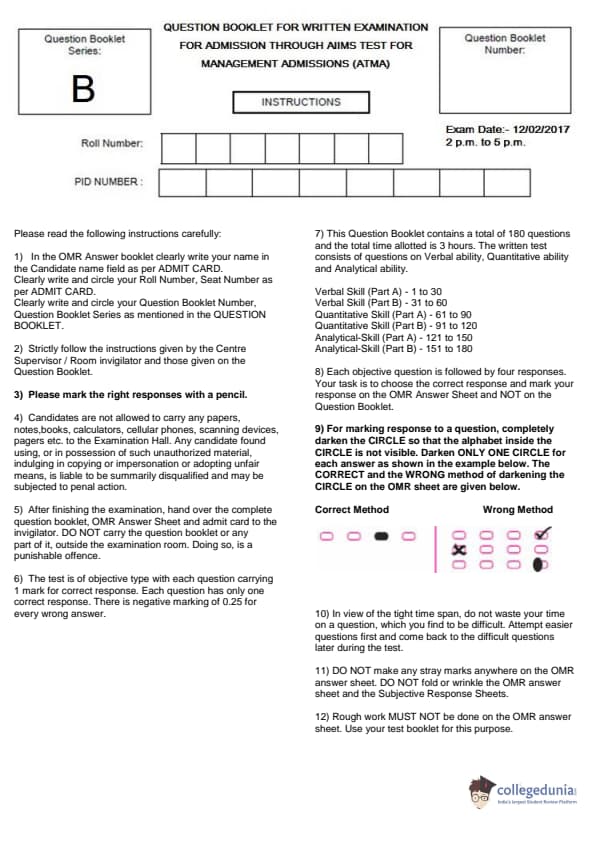
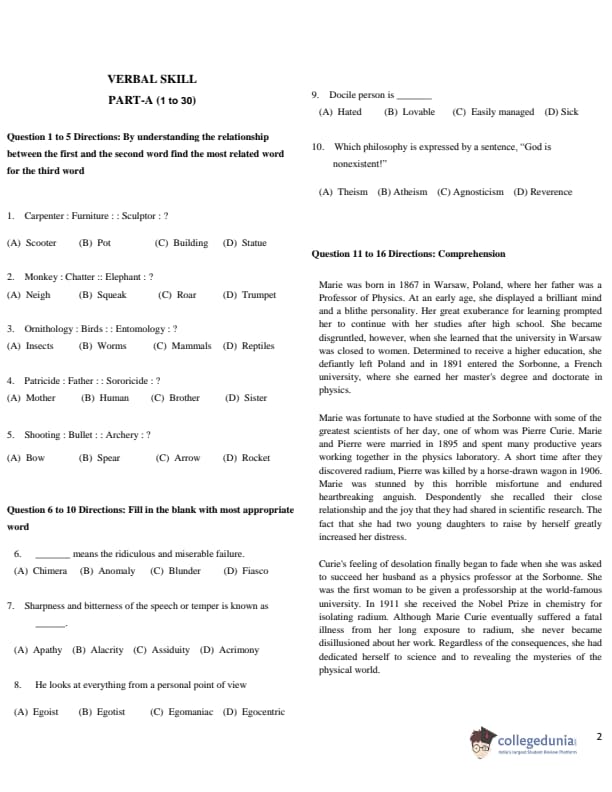
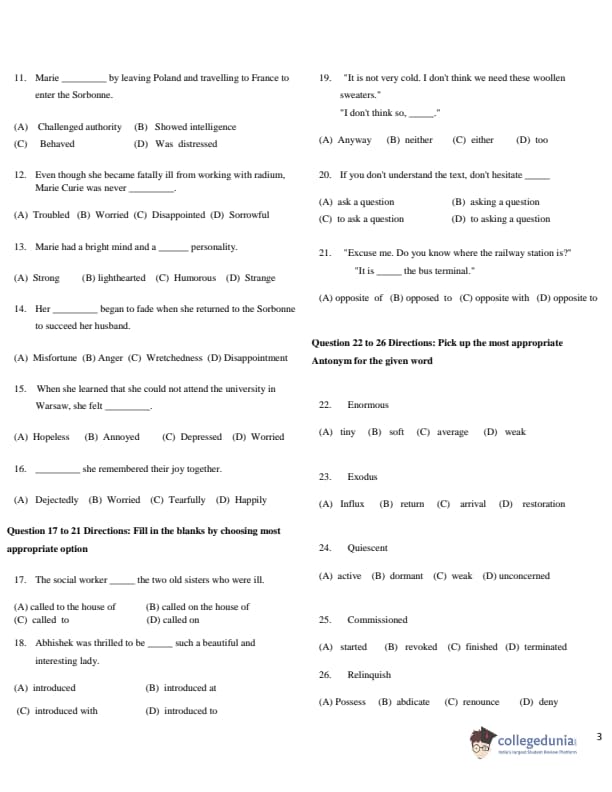
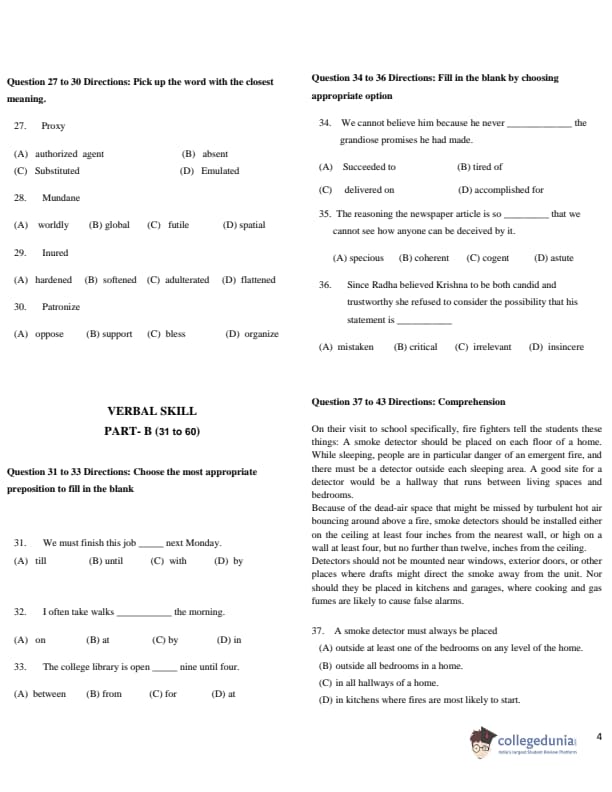
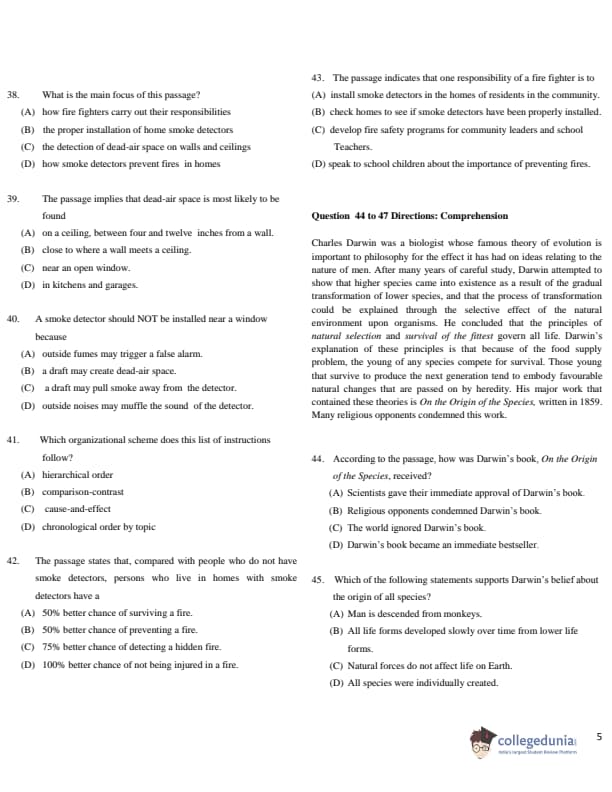
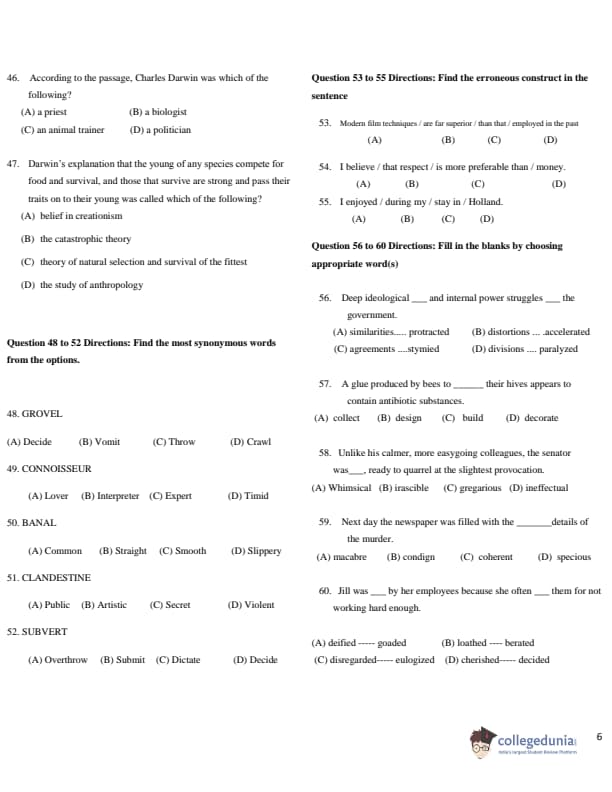
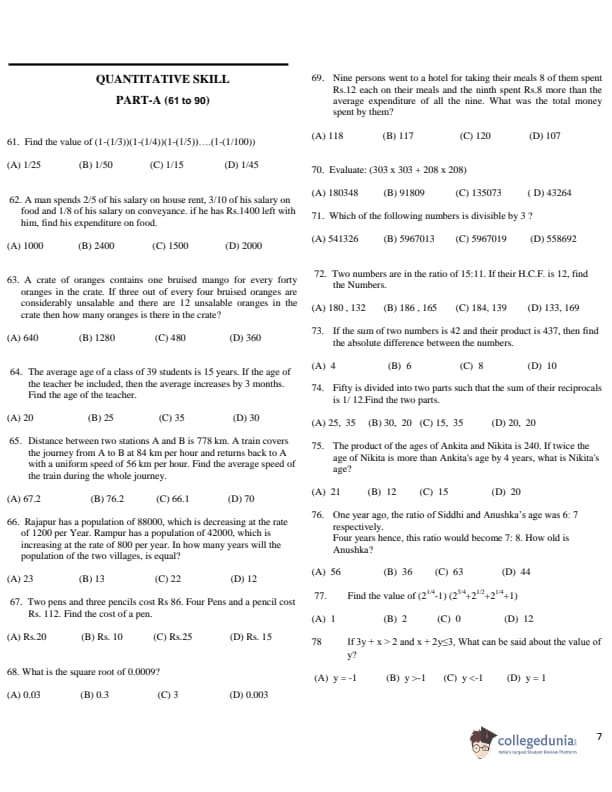
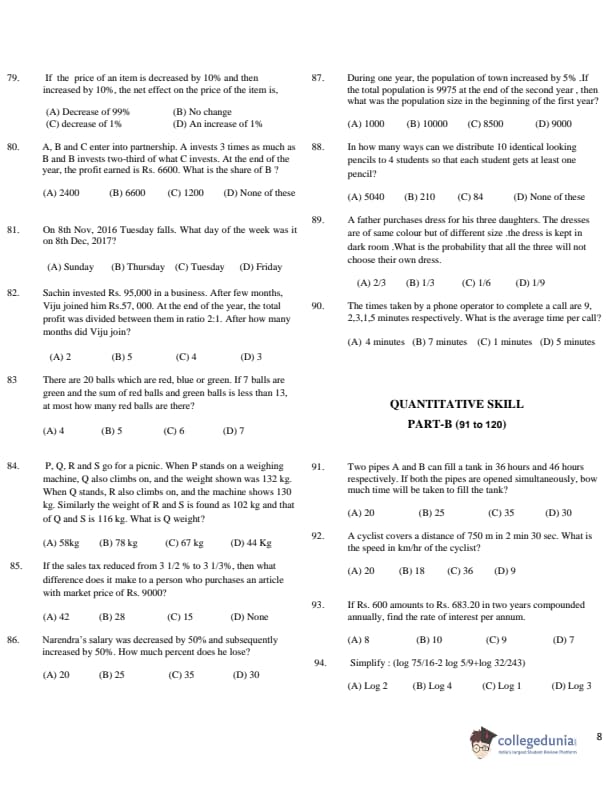
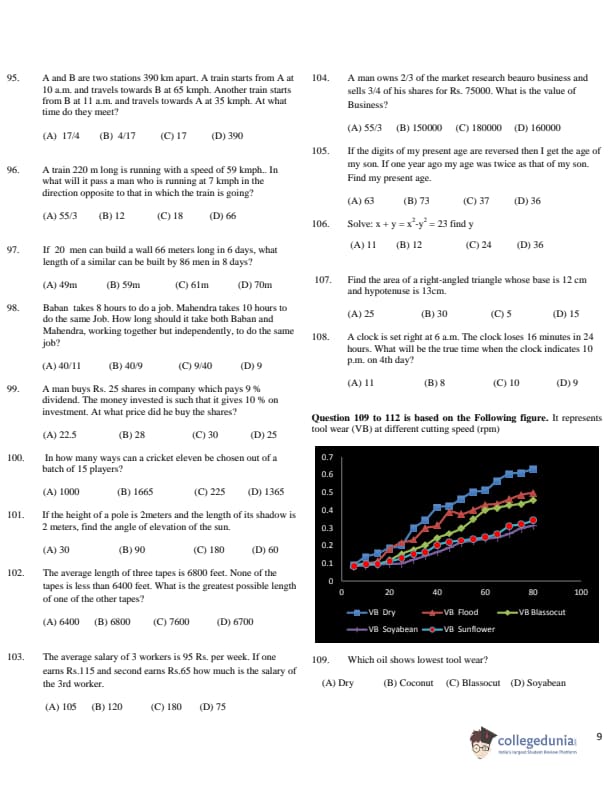
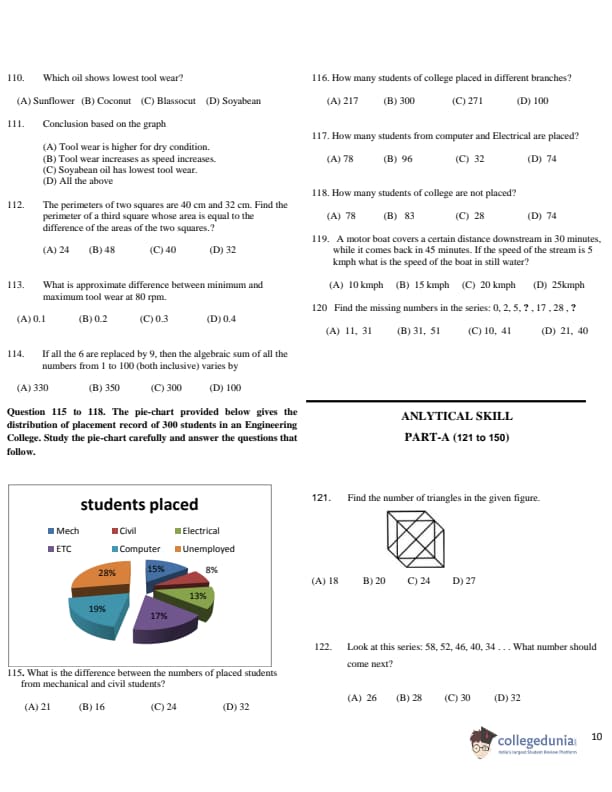

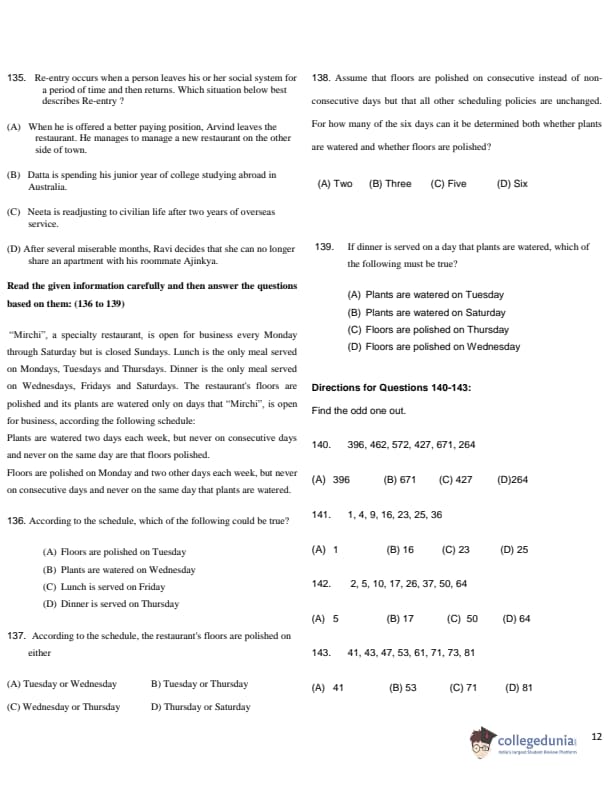
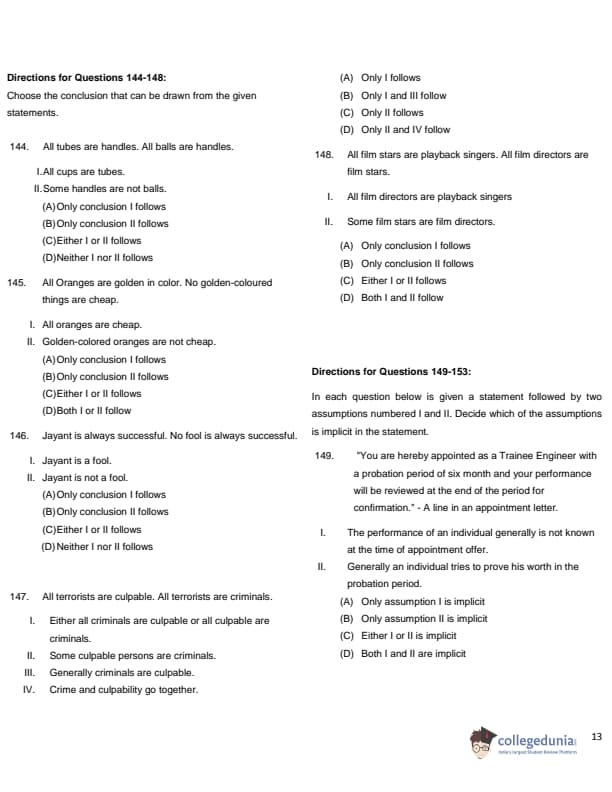
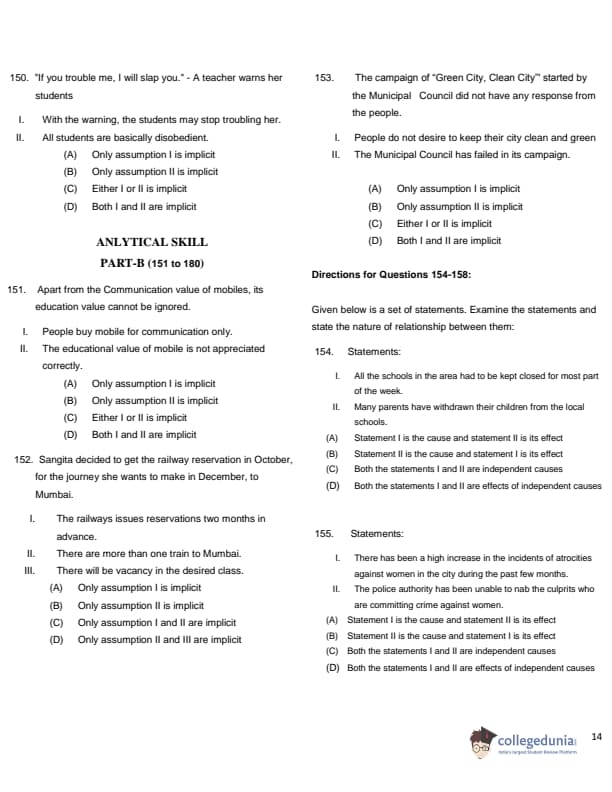

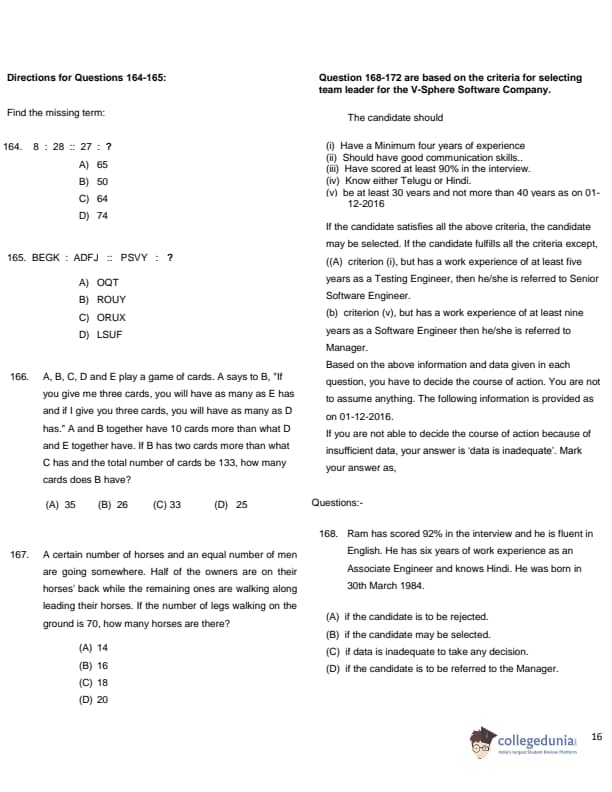
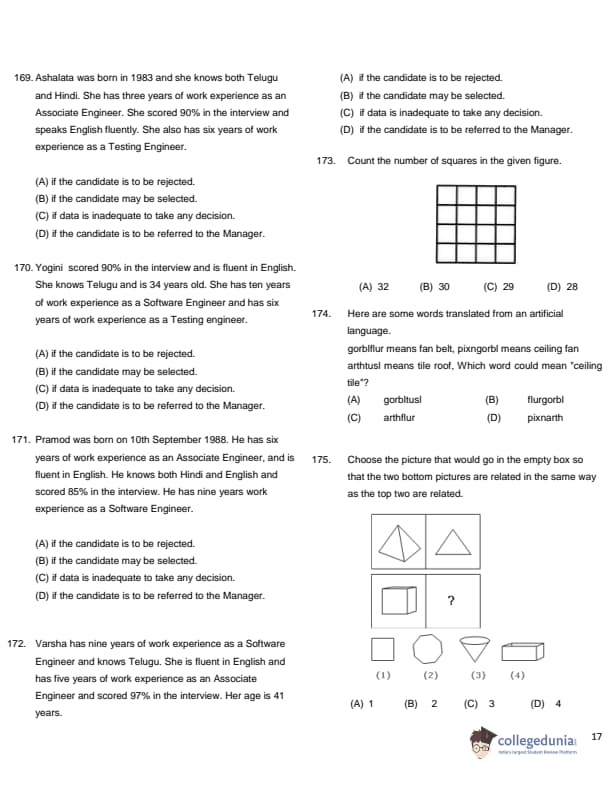
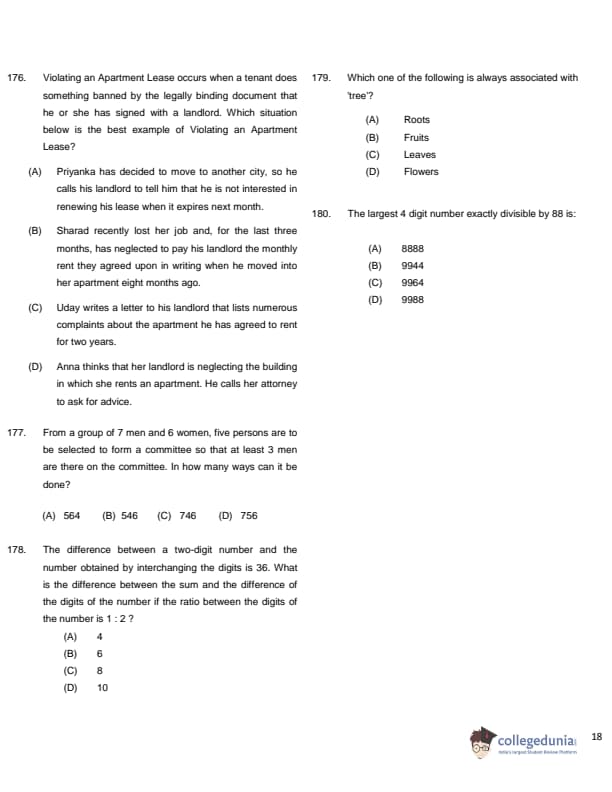

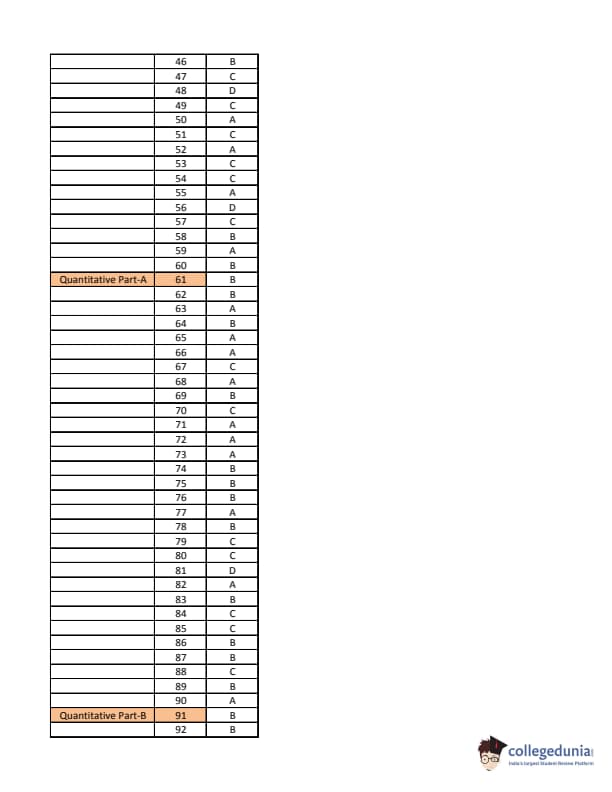
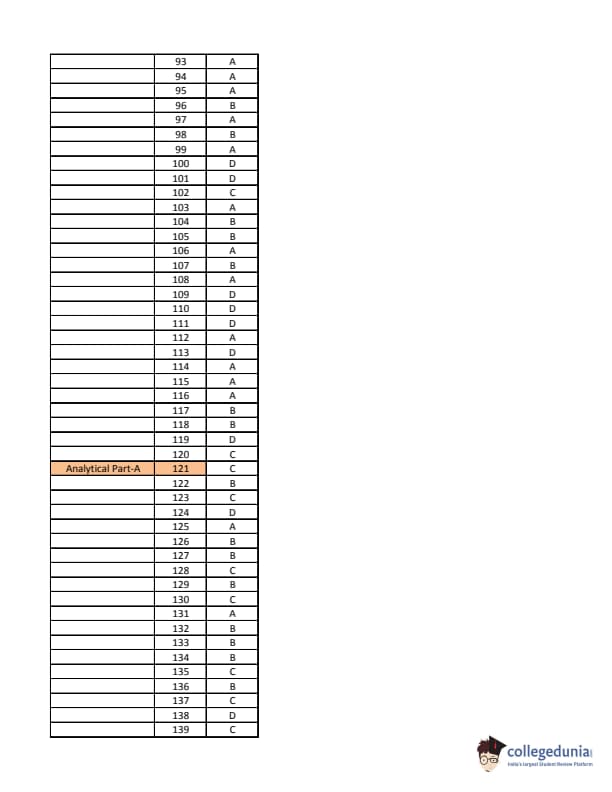
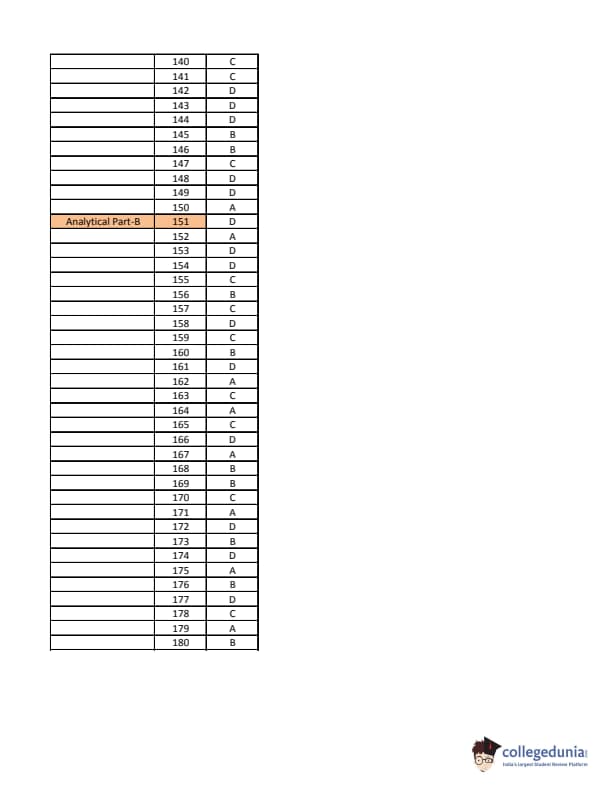







Comments